3D printing, also known as additive manufacturing, is a general term that encompasses several distinct 3D printing processes. These technologies are worlds apart, yet the key processes are the same. For instance, all 3D printing begins with a digital model, as the technology is inherently digital. Parts or products are initially designed using Computer-Aided Design (CAD) software or obtained from electronic files in a digital parts library. The design files are then sliced into layers by specialized software for 3D printing, generating path instructions for the 3D printer to follow. Next, you will learn about the differences between these technologies and the typical uses of each.Why are there 7 types?
Additive manufacturing types can be classified based on the products they produce or the types of materials used. The International Organization for Standardization (ISO) divides them into seven general types (though these seven 3D printing categories may not fully encompass the increasing number of technological subtypes and hybrid technologies):● Material Extrusion● Photopolymerization● Powder Bed Fusion● Material Jetting● Binder Jetting● Directed Energy Deposition● Sheet Lamination1. Material Extrusion
 △ Material Extrusion 3D Printing
Material extrusion, as the name suggests, involves extruding material through a nozzle. Typically, this material is a type of plastic filament, melted and extruded through a heated nozzle. The printer places the material on the build platform along a process path obtained through software. The filament then cools and solidifies to form a solid object. This is the most common form of 3D printing. At first glance, this seems simple, but considering the extruded materials, including plastics, metals, concrete, biogels, and various foods, it is actually a very broad category. This type of 3D printer ranges from $100 to seven figures.● Subtypes of material extrusion: Fused Deposition Modeling (FDM), Construction 3D Printing, Micro 3D Printing, Bio 3D Printing● Materials: Plastics, Metals, Foods, Concrete, etc.● Dimensional Accuracy: ±0.5% (lower limit ±0.5mm)● Common Applications: Prototyping, Electrical Enclosures, Shape and Fit Testing, Fixtures and Jigs, Investment Casting Models, Housing, etc.● Advantages: The lowest cost 3D printing method, wide range of materials● Disadvantages: Typically lower material properties (strength, durability, etc.), usually lower dimensional accuracy1. Fused Deposition Modeling (FDM)
△ Material Extrusion 3D Printing
Material extrusion, as the name suggests, involves extruding material through a nozzle. Typically, this material is a type of plastic filament, melted and extruded through a heated nozzle. The printer places the material on the build platform along a process path obtained through software. The filament then cools and solidifies to form a solid object. This is the most common form of 3D printing. At first glance, this seems simple, but considering the extruded materials, including plastics, metals, concrete, biogels, and various foods, it is actually a very broad category. This type of 3D printer ranges from $100 to seven figures.● Subtypes of material extrusion: Fused Deposition Modeling (FDM), Construction 3D Printing, Micro 3D Printing, Bio 3D Printing● Materials: Plastics, Metals, Foods, Concrete, etc.● Dimensional Accuracy: ±0.5% (lower limit ±0.5mm)● Common Applications: Prototyping, Electrical Enclosures, Shape and Fit Testing, Fixtures and Jigs, Investment Casting Models, Housing, etc.● Advantages: The lowest cost 3D printing method, wide range of materials● Disadvantages: Typically lower material properties (strength, durability, etc.), usually lower dimensional accuracy1. Fused Deposition Modeling (FDM)
 △ FDM parts can be made from metal or plastic on various 3D printers
FDM 3D printers represent a multi-billion dollar market, with thousands of machines ranging from basic models to complex manufacturer models. FDM machines are known as Fused Filament Fabrication (FFF), which is the same technology. Like all 3D printing technologies, FDM starts with a digital model, which is then converted into paths that the 3D printer can follow. In FDM, a single (or several at once) filament from a spool is loaded into the 3D printer and fed into the printer nozzle in the extrusion head. The printer nozzle or multiple nozzles are heated to the required temperature to soften the filament, allowing continuous layers to connect to form a solid part.As the printer moves the extrusion head along specified coordinates in the XY plane, it continues to lay down the first layer. The extrusion head then rises to the next height (Z plane), repeating the process of printing the cross-section layer by layer until the object is fully formed. Depending on the geometry of the object, support structures may sometimes need to be added to support the model during printing, such as when the model has steep overhangs. These supports are removed after printing. Some support structure materials can dissolve in water or another solution.
△ FDM parts can be made from metal or plastic on various 3D printers
FDM 3D printers represent a multi-billion dollar market, with thousands of machines ranging from basic models to complex manufacturer models. FDM machines are known as Fused Filament Fabrication (FFF), which is the same technology. Like all 3D printing technologies, FDM starts with a digital model, which is then converted into paths that the 3D printer can follow. In FDM, a single (or several at once) filament from a spool is loaded into the 3D printer and fed into the printer nozzle in the extrusion head. The printer nozzle or multiple nozzles are heated to the required temperature to soften the filament, allowing continuous layers to connect to form a solid part.As the printer moves the extrusion head along specified coordinates in the XY plane, it continues to lay down the first layer. The extrusion head then rises to the next height (Z plane), repeating the process of printing the cross-section layer by layer until the object is fully formed. Depending on the geometry of the object, support structures may sometimes need to be added to support the model during printing, such as when the model has steep overhangs. These supports are removed after printing. Some support structure materials can dissolve in water or another solution.
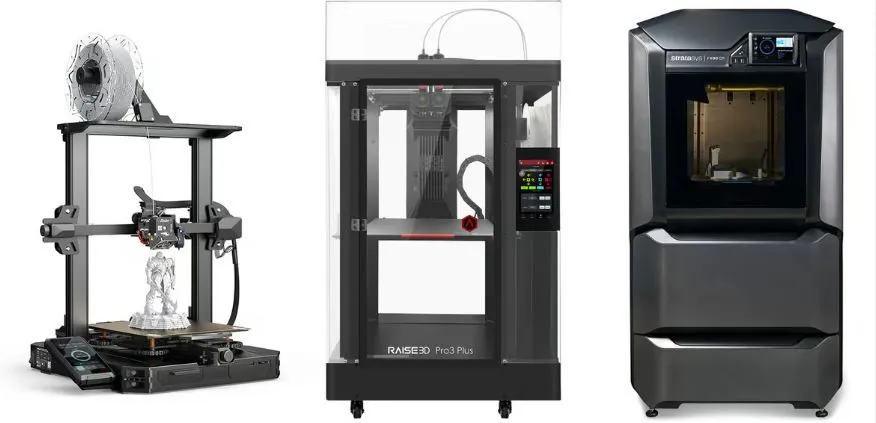 △ FDM 3D printers offer a wide range of machines for hobbyists, small businesses, and manufacturers (Source: Creality, Raise3D, Stratasys)
△ FDM 3D printers offer a wide range of machines for hobbyists, small businesses, and manufacturers (Source: Creality, Raise3D, Stratasys)
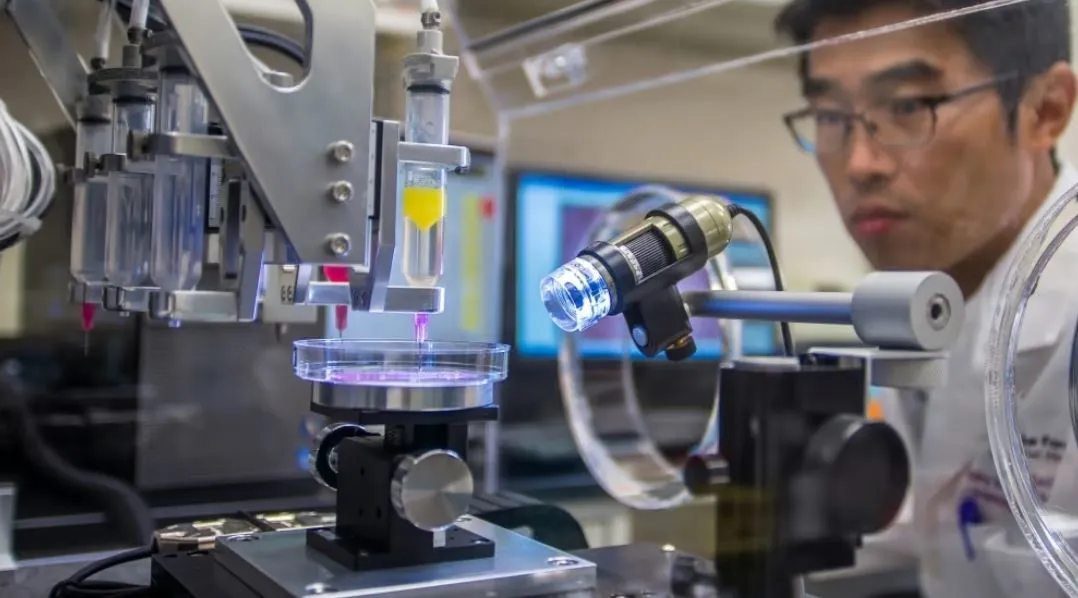 △ 3D Bio-printing is similar to traditional 3D printing, but with significant differences in materials
3D bio-printing or biological 3D printing is an additive manufacturing process that combines organic or biological materials (such as live cells and nutrients) to create natural three-dimensional structures resembling tissue. In other words, bio-printing is a 3D printing method that can produce anything from bone tissue and blood vessels to living tissues. It is used in various medical research and applications, including tissue engineering, drug testing and development, and innovative regenerative medicine therapies. The practical definition of 3D bio-printing is still evolving. Essentially, 3D bio-printing works similarly to FDM 3D printing and belongs to the material extrusion category (though extrusion is not the only bio-printing method).3D bio-printing uses materials expelled from a needle (bio-ink) to create printed layers. These materials, referred to as bio-inks, mainly consist of living substances, such as cells in carrier materials—like collagen, gelatin, hyaluronic acid, silk, alginate, or nanocellulose—serving as molecular scaffolds for structural growth and nutrients.3. Construction 3D Printing
△ 3D Bio-printing is similar to traditional 3D printing, but with significant differences in materials
3D bio-printing or biological 3D printing is an additive manufacturing process that combines organic or biological materials (such as live cells and nutrients) to create natural three-dimensional structures resembling tissue. In other words, bio-printing is a 3D printing method that can produce anything from bone tissue and blood vessels to living tissues. It is used in various medical research and applications, including tissue engineering, drug testing and development, and innovative regenerative medicine therapies. The practical definition of 3D bio-printing is still evolving. Essentially, 3D bio-printing works similarly to FDM 3D printing and belongs to the material extrusion category (though extrusion is not the only bio-printing method).3D bio-printing uses materials expelled from a needle (bio-ink) to create printed layers. These materials, referred to as bio-inks, mainly consist of living substances, such as cells in carrier materials—like collagen, gelatin, hyaluronic acid, silk, alginate, or nanocellulose—serving as molecular scaffolds for structural growth and nutrients.3. Construction 3D Printing
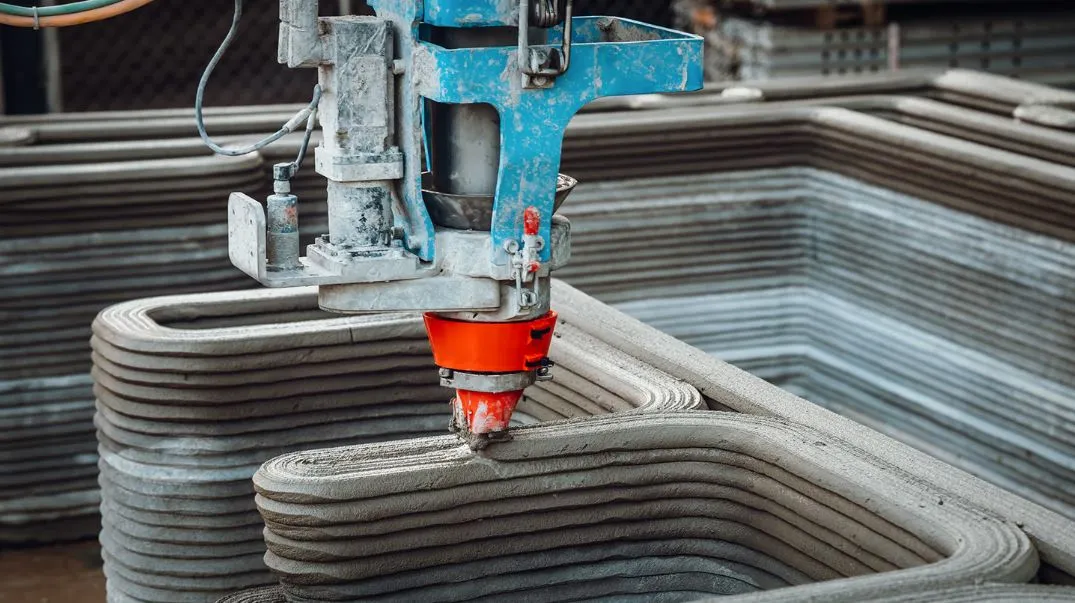 △ Construction 3D Printing
Construction 3D printing is a rapidly developing area of material extrusion. This technology involves using super-large 3D printers (often reaching several meters in height) to extrude construction materials such as concrete from a nozzle. These machines usually appear in the form of gantries or robotic arm systems. Today, 3D construction printing technology is used for residential buildings, architectural features, and construction projects ranging from wells to walls. Researchers suggest it could significantly change the entire construction industry by reducing labor requirements and minimizing construction waste.There are dozens of 3D printed houses in the United States and Europe, and research is underway to develop 3D construction technologies that will use materials found on the Moon and Mars to build habitats for future expeditions. Printing with local soil instead of concrete as a more sustainable construction method is also being explored.2. Photopolymerization
△ Construction 3D Printing
Construction 3D printing is a rapidly developing area of material extrusion. This technology involves using super-large 3D printers (often reaching several meters in height) to extrude construction materials such as concrete from a nozzle. These machines usually appear in the form of gantries or robotic arm systems. Today, 3D construction printing technology is used for residential buildings, architectural features, and construction projects ranging from wells to walls. Researchers suggest it could significantly change the entire construction industry by reducing labor requirements and minimizing construction waste.There are dozens of 3D printed houses in the United States and Europe, and research is underway to develop 3D construction technologies that will use materials found on the Moon and Mars to build habitats for future expeditions. Printing with local soil instead of concrete as a more sustainable construction method is also being explored.2. Photopolymerization
 △ Photopolymerization using lasers
Barrel polymerization (also known as resin 3D printing) is a series of 3D printing processes that use a light source to selectively cure (or harden) photosensitive polymer resin in a barrel. In other words, light precisely targets specific points or areas of liquid plastic to harden it. After the first layer is cured, the build platform moves up or down slightly (usually between 0.01 and 0.05 mm), and the next layer is cured, connecting with the previous layer. This process is repeated layer by layer until a 3D part is formed. After the 3D printing process is completed, the object is cleaned to remove any remaining liquid resin and post-cured (in sunlight or a UV chamber) to enhance the mechanical properties of the part.The three most common forms of barrel polymerization are Stereolithography (SLA), Digital Light Processing (DLP), and Liquid Crystal Display (LCD), also known as Masked Stereolithography (MSLA). The fundamental difference between these types of 3D printing technologies lies in the light source and how it is used to cure the resin.
△ Photopolymerization using lasers
Barrel polymerization (also known as resin 3D printing) is a series of 3D printing processes that use a light source to selectively cure (or harden) photosensitive polymer resin in a barrel. In other words, light precisely targets specific points or areas of liquid plastic to harden it. After the first layer is cured, the build platform moves up or down slightly (usually between 0.01 and 0.05 mm), and the next layer is cured, connecting with the previous layer. This process is repeated layer by layer until a 3D part is formed. After the 3D printing process is completed, the object is cleaned to remove any remaining liquid resin and post-cured (in sunlight or a UV chamber) to enhance the mechanical properties of the part.The three most common forms of barrel polymerization are Stereolithography (SLA), Digital Light Processing (DLP), and Liquid Crystal Display (LCD), also known as Masked Stereolithography (MSLA). The fundamental difference between these types of 3D printing technologies lies in the light source and how it is used to cure the resin.
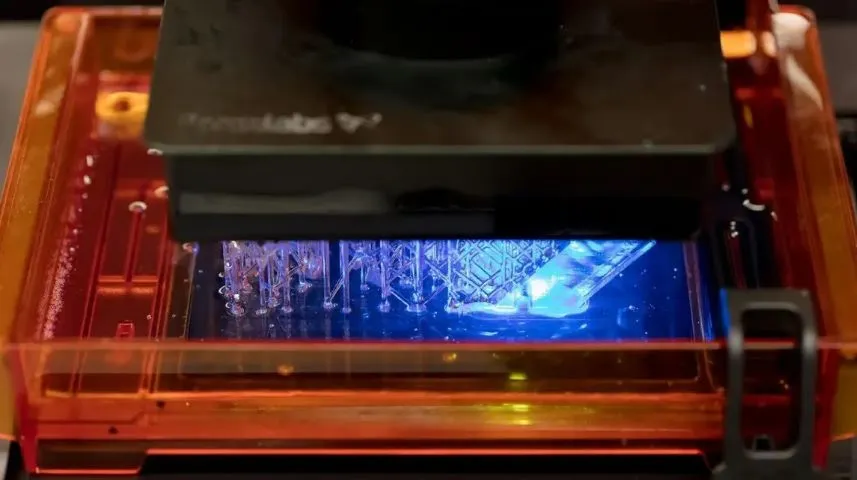 △ Large barrel polymerization utilizes light to cure photosensitive resin layer by layer
Some 3D printer manufacturers, especially those producing professional-grade 3D printers, have developed unique and patented variants of light polymerization, so you may see different technology names in the market. An industrial 3D printer manufacturer, Carbon, uses a barrel polymerization technology called Digital Light Synthesis (DLS), while Stratasys’s Origin refers to its technology as Programmable Photopolymerization (P3). Formlabs offers a technology known as Low Force Stereolithography (LFS), while Azul 3D is the first to commercialize a large area high-speed printing (HARP) form of barrel polymerization. There are also light-based metal manufacturing (LMM), Projection Micro-Stereolithography (PμSL), and Digital Composite Manufacturing (DCM), which is a light polymer technology that introduces functional additives (such as metal and ceramic fibers) into liquid resin.● Types of 3D printing technologies: Stereolithography (SLA), Liquid Crystal Display (LCD), Digital Light Processing (DLP), Micro-Stereolithography (μSLA), etc.● Materials: Photopolymer resins (castable, transparent, industrial, biocompatible, etc.)● Dimensional Accuracy: ±0.5% (lower limit ±0.15 mm or 5 nm, using μSLA)● Common Applications: Injection molding polymer prototypes and end-use parts, jewelry casting, dental applications, consumer products● Advantages: Smooth surface finish, fine feature details1. Stereolithography (SLA)
△ Large barrel polymerization utilizes light to cure photosensitive resin layer by layer
Some 3D printer manufacturers, especially those producing professional-grade 3D printers, have developed unique and patented variants of light polymerization, so you may see different technology names in the market. An industrial 3D printer manufacturer, Carbon, uses a barrel polymerization technology called Digital Light Synthesis (DLS), while Stratasys’s Origin refers to its technology as Programmable Photopolymerization (P3). Formlabs offers a technology known as Low Force Stereolithography (LFS), while Azul 3D is the first to commercialize a large area high-speed printing (HARP) form of barrel polymerization. There are also light-based metal manufacturing (LMM), Projection Micro-Stereolithography (PμSL), and Digital Composite Manufacturing (DCM), which is a light polymer technology that introduces functional additives (such as metal and ceramic fibers) into liquid resin.● Types of 3D printing technologies: Stereolithography (SLA), Liquid Crystal Display (LCD), Digital Light Processing (DLP), Micro-Stereolithography (μSLA), etc.● Materials: Photopolymer resins (castable, transparent, industrial, biocompatible, etc.)● Dimensional Accuracy: ±0.5% (lower limit ±0.15 mm or 5 nm, using μSLA)● Common Applications: Injection molding polymer prototypes and end-use parts, jewelry casting, dental applications, consumer products● Advantages: Smooth surface finish, fine feature details1. Stereolithography (SLA)
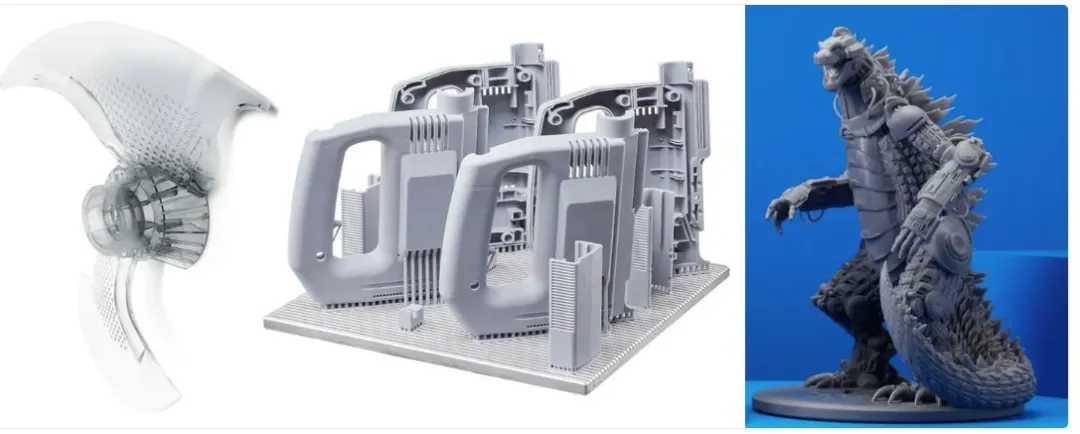 △ SLA 3D printing examples from 3D Systems, DWS, and Formlabs
SLA is the world’s first 3D printing technology. The Stereolithography technique was invented by Chuck Hull in 1986, who patented the technology and founded 3D Systems to commercialize it. Today, this technology is available to enthusiasts and professionals from many 3D printer manufacturers. SLA uses a laser beam to target a barrel of resin, selectively curing the cross-section of the object within the printing area, building layer by layer. While most SLA printers use solid-state lasers to cure parts, one disadvantage of this barrel polymerization is that the point laser may take longer to trace the cross-section of the object compared to our next method (DLP), which flashes light to immediately cure the entire layer. However, lasers can produce stronger light, which is required for certain engineering-grade resins.
△ SLA 3D printing examples from 3D Systems, DWS, and Formlabs
SLA is the world’s first 3D printing technology. The Stereolithography technique was invented by Chuck Hull in 1986, who patented the technology and founded 3D Systems to commercialize it. Today, this technology is available to enthusiasts and professionals from many 3D printer manufacturers. SLA uses a laser beam to target a barrel of resin, selectively curing the cross-section of the object within the printing area, building layer by layer. While most SLA printers use solid-state lasers to cure parts, one disadvantage of this barrel polymerization is that the point laser may take longer to trace the cross-section of the object compared to our next method (DLP), which flashes light to immediately cure the entire layer. However, lasers can produce stronger light, which is required for certain engineering-grade resins.
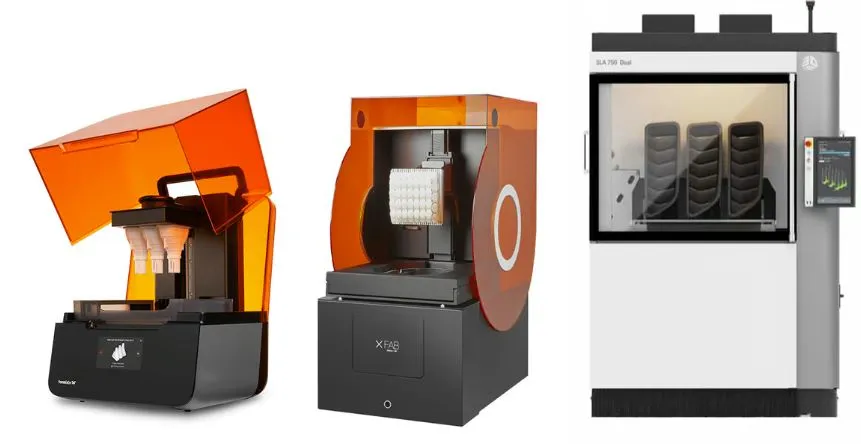 △ SLA 3D printers use one or more lasers to trace and cure a single layer of resin at a time
Micro-Stereolithography (μSLA)Micro-Stereolithography technology can print miniature parts with resolutions between 2 microns (μm) and 50 microns. For reference, the average width of human hair is 75 microns. It is one of the “micro 3D printing” technologies. μSLA involves exposing a photosensitive material (liquid resin) to UV lasers. The difference lies in the specialized resin, complexity of the laser, and the addition of lenses that produce almost unbelievably small light spots.
△ SLA 3D printers use one or more lasers to trace and cure a single layer of resin at a time
Micro-Stereolithography (μSLA)Micro-Stereolithography technology can print miniature parts with resolutions between 2 microns (μm) and 50 microns. For reference, the average width of human hair is 75 microns. It is one of the “micro 3D printing” technologies. μSLA involves exposing a photosensitive material (liquid resin) to UV lasers. The difference lies in the specialized resin, complexity of the laser, and the addition of lenses that produce almost unbelievably small light spots.
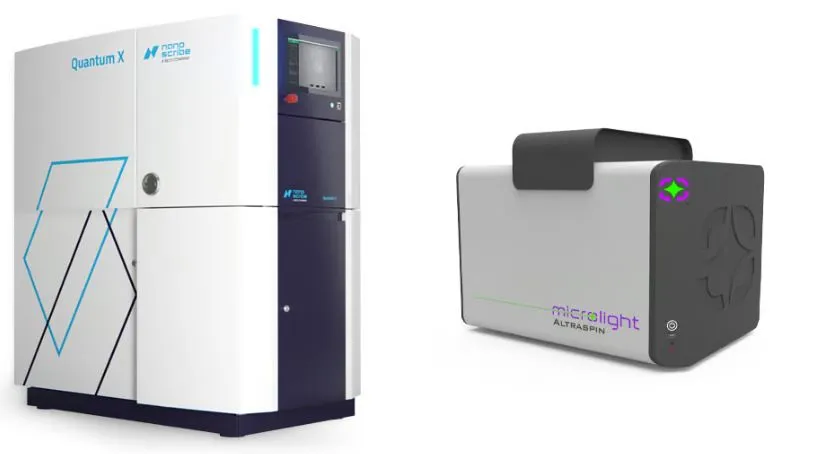 △ Nanoscribe and Microlight3D are two leading manufacturers of TPP 3D printers (Source: Nanoscribe, Microlight3D)
Two-Photon Polymerization (TPP)Another micro 3D printing technology, TPP (also called 2PP), can be classified under SLA as it also uses lasers and photosensitive resins, capable of printing parts smaller than μSLA, down to 0.1 microns. TPP uses pulsed femtosecond lasers focused on a narrow point in a large barrel of special resin. This point then cures individual 3D pixels, also known as voxels, in the resin. By successively curing these nano- to micro-sized small voxels layer by layer along a predefined path, TPP is currently used in research, medical applications, and the manufacturing of micro parts, such as micro electrodes and optical sensors.
2. Digital Light Processing (DLP)
△ Nanoscribe and Microlight3D are two leading manufacturers of TPP 3D printers (Source: Nanoscribe, Microlight3D)
Two-Photon Polymerization (TPP)Another micro 3D printing technology, TPP (also called 2PP), can be classified under SLA as it also uses lasers and photosensitive resins, capable of printing parts smaller than μSLA, down to 0.1 microns. TPP uses pulsed femtosecond lasers focused on a narrow point in a large barrel of special resin. This point then cures individual 3D pixels, also known as voxels, in the resin. By successively curing these nano- to micro-sized small voxels layer by layer along a predefined path, TPP is currently used in research, medical applications, and the manufacturing of micro parts, such as micro electrodes and optical sensors.
2. Digital Light Processing (DLP)
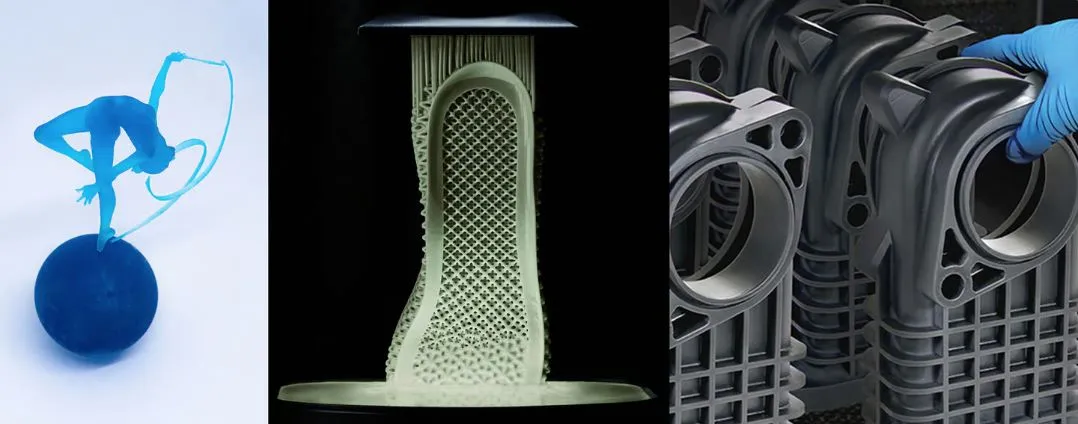 △ DLP 3D printed parts from Anycubic, Carbon, and ETEC
DLP 3D printing uses a digital light projector (instead of lasers) to flash a single image of each layer (or multiple exposures for larger parts) simultaneously onto a layer of resin. DLP (more common than SLA) is used to produce larger parts or parts with larger volumes in a single batch because every layer exposure takes the same amount of time regardless of how many parts are in the build, making it more efficient than the point laser method in SLA. Each layer’s image consists of square pixels, resulting in a layer formed from small rectangular blocks called voxels. Light is projected onto the resin using LED screens or UV light sources (lamps) and is directed to the build surface via Digital Micromirror Devices (DMD).
△ DLP 3D printed parts from Anycubic, Carbon, and ETEC
DLP 3D printing uses a digital light projector (instead of lasers) to flash a single image of each layer (or multiple exposures for larger parts) simultaneously onto a layer of resin. DLP (more common than SLA) is used to produce larger parts or parts with larger volumes in a single batch because every layer exposure takes the same amount of time regardless of how many parts are in the build, making it more efficient than the point laser method in SLA. Each layer’s image consists of square pixels, resulting in a layer formed from small rectangular blocks called voxels. Light is projected onto the resin using LED screens or UV light sources (lamps) and is directed to the build surface via Digital Micromirror Devices (DMD).
 △ Digital Light Processing (DLP) resin 3D printers come in hobbyist versions and full manufacturing production machines
Modern DLP projectors typically have thousands of micrometer-sized LEDs as light sources. Their switching states are controlled individually, which can improve XY resolution. Not all DLP 3D printers are the same; the power of the light source, the quality of the lenses it passes through, and many other components that make up a machine worth $300 can differ significantly from one worth over $200,000.Top-Down DLP
Some DLP 3D printers have the light source mounted on top of the printer, shining down on the resin vat rather than shining up. These “top-down” machines flash an image of a layer from above, curing one layer at a time, then the cured layer is returned to the large vat. Each time the build plate is lowered, a recoater mounted on top of the vat moves back and forth over the resin to smooth the new layer. Manufacturers claim that this method can produce more stable parts output for larger prints because the process does not have to fight against gravity. When printing from the bottom up, there are limits to how much weight can be suspended from the build plate. The resin vat also supports the printed parts during printing, reducing the need for support structures.
Projection Micro-Stereolithography (PμSL)As a unique type of barrel polymerization, PμSL can be classified as a subtype of DLP. This is another micro 3D printing technology. PμSL uses UV light from a projector to cure layers of specially formulated resin at the micron level (2 microns resolution and as low as 5 microns layer height). This additive manufacturing technology is continuously evolving due to its low cost, accuracy, speed, and the range of materials available (including polymers, biomaterials, and ceramics) and has shown potential applications ranging from microfluidics and tissue engineering to micro-optics and biomedical micro-devices.Light-based Metal Manufacturing (LMM)This is another “relative” of DLP; this method of 3D printing using light and resin can create small metal parts for applications such as surgical tools and micromechanical components. In LMM, metal powder is evenly dispersed in a photosensitive resin and then selectively polymerized using blue light exposure from a projector. After printing, the polymer component of the green part is removed, leaving fully metal debound parts, which are completed during the sintering process in a furnace. Materials include stainless steel, titanium, tungsten, brass, copper, silver, and gold.
3. Liquid Crystal Display (LCD)
△ Digital Light Processing (DLP) resin 3D printers come in hobbyist versions and full manufacturing production machines
Modern DLP projectors typically have thousands of micrometer-sized LEDs as light sources. Their switching states are controlled individually, which can improve XY resolution. Not all DLP 3D printers are the same; the power of the light source, the quality of the lenses it passes through, and many other components that make up a machine worth $300 can differ significantly from one worth over $200,000.Top-Down DLP
Some DLP 3D printers have the light source mounted on top of the printer, shining down on the resin vat rather than shining up. These “top-down” machines flash an image of a layer from above, curing one layer at a time, then the cured layer is returned to the large vat. Each time the build plate is lowered, a recoater mounted on top of the vat moves back and forth over the resin to smooth the new layer. Manufacturers claim that this method can produce more stable parts output for larger prints because the process does not have to fight against gravity. When printing from the bottom up, there are limits to how much weight can be suspended from the build plate. The resin vat also supports the printed parts during printing, reducing the need for support structures.
Projection Micro-Stereolithography (PμSL)As a unique type of barrel polymerization, PμSL can be classified as a subtype of DLP. This is another micro 3D printing technology. PμSL uses UV light from a projector to cure layers of specially formulated resin at the micron level (2 microns resolution and as low as 5 microns layer height). This additive manufacturing technology is continuously evolving due to its low cost, accuracy, speed, and the range of materials available (including polymers, biomaterials, and ceramics) and has shown potential applications ranging from microfluidics and tissue engineering to micro-optics and biomedical micro-devices.Light-based Metal Manufacturing (LMM)This is another “relative” of DLP; this method of 3D printing using light and resin can create small metal parts for applications such as surgical tools and micromechanical components. In LMM, metal powder is evenly dispersed in a photosensitive resin and then selectively polymerized using blue light exposure from a projector. After printing, the polymer component of the green part is removed, leaving fully metal debound parts, which are completed during the sintering process in a furnace. Materials include stainless steel, titanium, tungsten, brass, copper, silver, and gold.
3. Liquid Crystal Display (LCD)
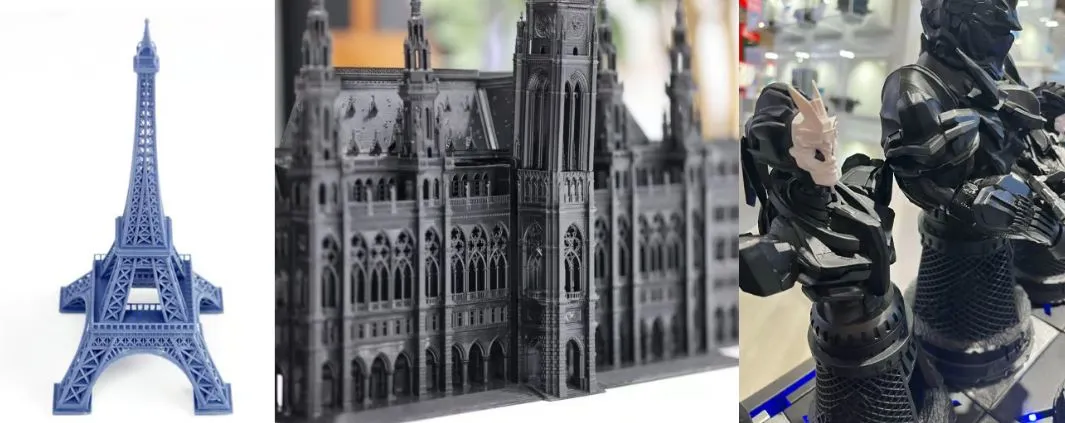 △ LCD 3D printed parts from Elegoo, Photocentric, and Nexa3D
Liquid Crystal Display (LCD), also known as Masked Stereolithography (MSLA), is very similar to the DLP mentioned above, except it uses an LCD screen instead of Digital Micromirror Devices (DMD), which significantly affects the price of the 3D printer. Like DLP, the LCD light mask is a digital display made up of square pixels. The pixel size of the LCD light mask determines the granularity of the print. Therefore, the XY accuracy is fixed and does not rely on how much zoom or scaling the lens does, as is the case with DLP. Another difference between DLP printers and LCD technology is that the latter uses an array of hundreds of individual emitters instead of a single-point emitting light source like laser diodes or DLP bulbs.
△ LCD 3D printed parts from Elegoo, Photocentric, and Nexa3D
Liquid Crystal Display (LCD), also known as Masked Stereolithography (MSLA), is very similar to the DLP mentioned above, except it uses an LCD screen instead of Digital Micromirror Devices (DMD), which significantly affects the price of the 3D printer. Like DLP, the LCD light mask is a digital display made up of square pixels. The pixel size of the LCD light mask determines the granularity of the print. Therefore, the XY accuracy is fixed and does not rely on how much zoom or scaling the lens does, as is the case with DLP. Another difference between DLP printers and LCD technology is that the latter uses an array of hundreds of individual emitters instead of a single-point emitting light source like laser diodes or DLP bulbs.
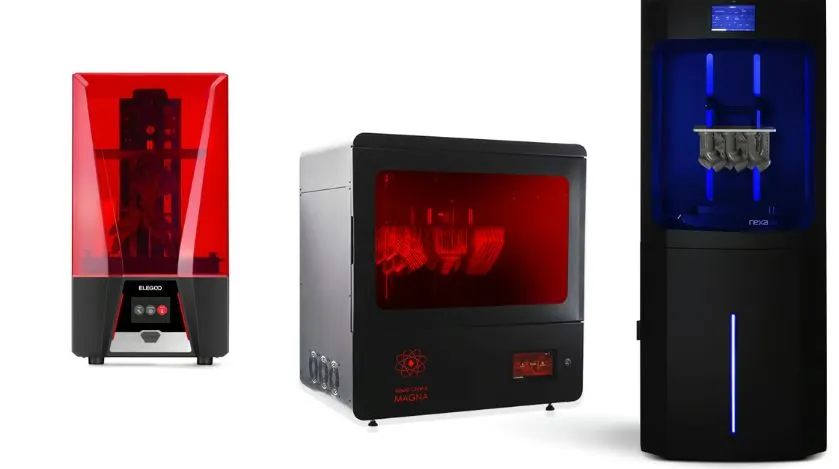 △ Today, LCD resin 3D printing technology is shifting from consumer machines to industrial machines
Like DLP, LCD can achieve faster printing times than SLA under certain conditions. This is because the entire layer is exposed at once, rather than tracing the cross-section with a laser point. Due to the low cost of LCD units, this technology has become the preferred technology in the field of low-cost desktop resin printers, but that does not mean it has not been used professionally; some industrial 3D printer manufacturers are pushing the limits of technology and achieving remarkable results.3. Powder Bed Fusion
△ Today, LCD resin 3D printing technology is shifting from consumer machines to industrial machines
Like DLP, LCD can achieve faster printing times than SLA under certain conditions. This is because the entire layer is exposed at once, rather than tracing the cross-section with a laser point. Due to the low cost of LCD units, this technology has become the preferred technology in the field of low-cost desktop resin printers, but that does not mean it has not been used professionally; some industrial 3D printer manufacturers are pushing the limits of technology and achieving remarkable results.3. Powder Bed Fusion
 △ Powder Bed Fusion
Powder Bed Fusion (PBF) is a 3D printing process in which a heat source selectively melts powder particles (plastic, metal, or ceramic) in the build area to create solid objects layer by layer. PBF 3D printers spread a thin layer of powder material on the print bed, typically using a blade, roller, or squeegee. Energy from a laser fuses specific points on the powder layer, then another powder layer is deposited and fused to the previous layer. This process is repeated until the entire object is manufactured, with the final product being surrounded and supported by unfused powder.
△ Powder Bed Fusion
Powder Bed Fusion (PBF) is a 3D printing process in which a heat source selectively melts powder particles (plastic, metal, or ceramic) in the build area to create solid objects layer by layer. PBF 3D printers spread a thin layer of powder material on the print bed, typically using a blade, roller, or squeegee. Energy from a laser fuses specific points on the powder layer, then another powder layer is deposited and fused to the previous layer. This process is repeated until the entire object is manufactured, with the final product being surrounded and supported by unfused powder.
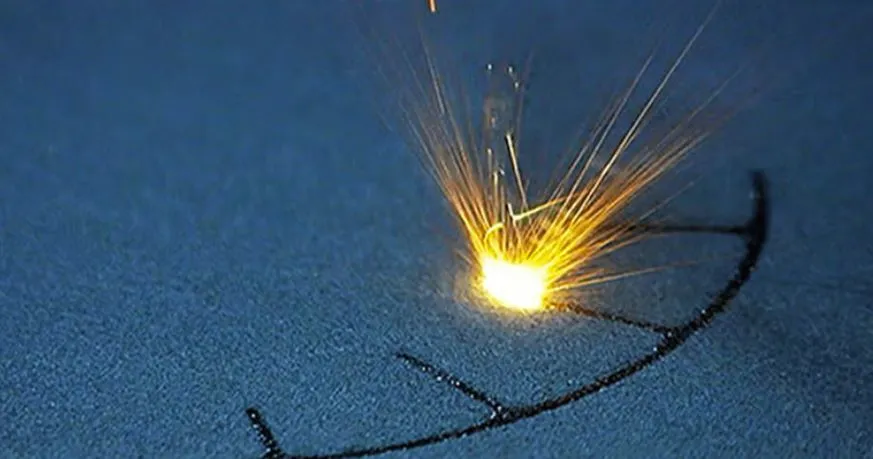 △ Metal laser powder bed fusion process
PBF can produce parts with high mechanical properties (including strength, wear resistance, and durability) for end-use in consumer products, machinery, and tools. 3D printers in this segment are becoming increasingly affordable (starting around $25,000), but it is considered an industrial technology.● Types of 3D printing technologies: Selective Laser Sintering (SLS), Laser Powder Bed Fusion (LPBF), Electron Beam Melting (EBM)● Materials: Plastic powder, metal powder, ceramic powder● Dimensional Accuracy: ±0.3% (lower limit ±0.3mm)● Common Applications: Functional parts, complex ducts (hollow designs), low-volume part production● Advantages: Functional parts, excellent mechanical properties, complex geometries● Disadvantages: High machine costs, typically high-cost materials, slower build speeds1. Selective Laser Sintering (SLS)
△ Metal laser powder bed fusion process
PBF can produce parts with high mechanical properties (including strength, wear resistance, and durability) for end-use in consumer products, machinery, and tools. 3D printers in this segment are becoming increasingly affordable (starting around $25,000), but it is considered an industrial technology.● Types of 3D printing technologies: Selective Laser Sintering (SLS), Laser Powder Bed Fusion (LPBF), Electron Beam Melting (EBM)● Materials: Plastic powder, metal powder, ceramic powder● Dimensional Accuracy: ±0.3% (lower limit ±0.3mm)● Common Applications: Functional parts, complex ducts (hollow designs), low-volume part production● Advantages: Functional parts, excellent mechanical properties, complex geometries● Disadvantages: High machine costs, typically high-cost materials, slower build speeds1. Selective Laser Sintering (SLS)
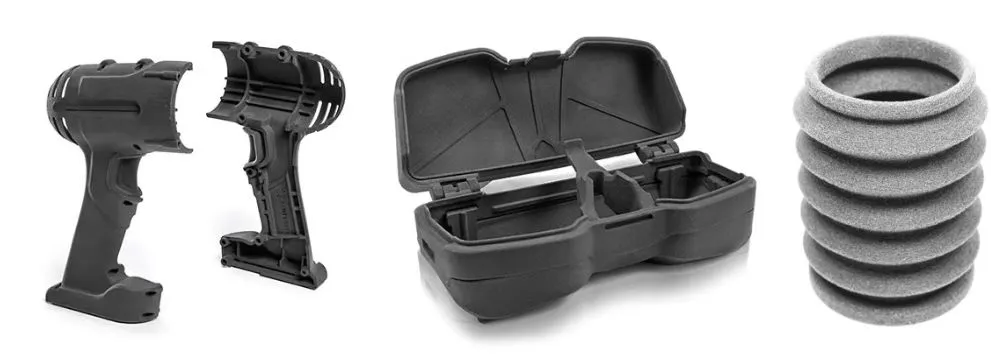 △ Sinterit’s SLS 3D printed parts
Selective Laser Sintering (SLS) uses lasers to create objects from plastic powder. First, a box of polymer powder is heated to just below the polymer melting point. A very thin layer of powder material (usually 0.1 mm thick) is then deposited onto the build platform using a recoating blade or squeegee. The laser begins to scan the surface according to the pattern laid out in the digital model. The laser selectively sinters the powder and solidifies the cross-section of the object. As the entire cross-section is scanned, the build platform moves down one layer thickness. The recoating blade deposits a new layer of powder on the recently scanned layer, and the laser sinters the next cross-section of the object to the previously solidified cross-section.
△ Sinterit’s SLS 3D printed parts
Selective Laser Sintering (SLS) uses lasers to create objects from plastic powder. First, a box of polymer powder is heated to just below the polymer melting point. A very thin layer of powder material (usually 0.1 mm thick) is then deposited onto the build platform using a recoating blade or squeegee. The laser begins to scan the surface according to the pattern laid out in the digital model. The laser selectively sinters the powder and solidifies the cross-section of the object. As the entire cross-section is scanned, the build platform moves down one layer thickness. The recoating blade deposits a new layer of powder on the recently scanned layer, and the laser sinters the next cross-section of the object to the previously solidified cross-section.
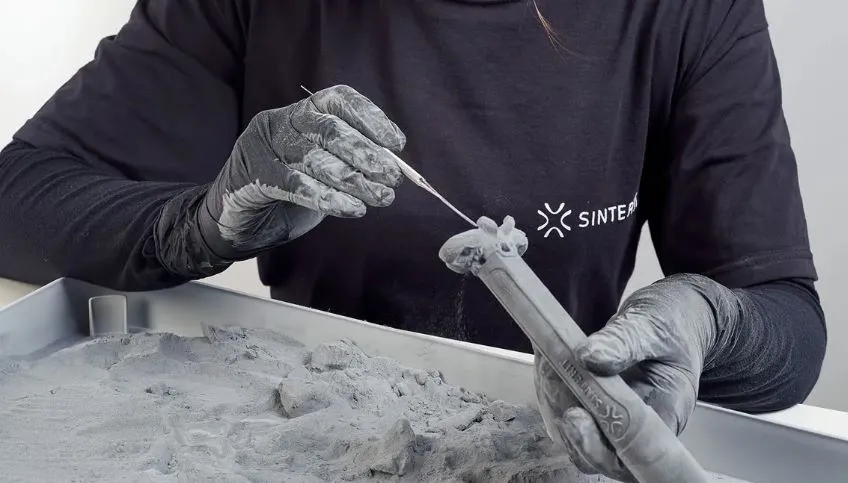 △ SLS 3D printed parts can be manually or automatically depowdered and cleaned
These steps are repeated until all objects are manufactured. The unsintered powder remains in place to support the object, reducing or eliminating the need for support structures. After parts are removed from the powder bed and cleaned, no additional post-processing steps are necessary. Parts can be polished, coated, or colored. There are many differentiating factors between SLS 3D printers, including not only their size but also the power and number of lasers, laser spot size, heating bed time and method, and how powder is distributed. The most common materials in SLS 3D printing are nylon (PA6, PA12), but flexible parts can also be printed using TPU and other materials.
2. Micro-Selective Laser Sintering (μSLS)μSLS belongs to the SLS or Laser Powder Bed Fusion (LPBF) technology described below. It uses lasers to sinter powdered materials like SLS, but this material is typically metal rather than plastic, making it more like LPBF. It is another micro 3D printing technology that can create parts at micro (below 5 μm) resolution.
△ SLS 3D printed parts can be manually or automatically depowdered and cleaned
These steps are repeated until all objects are manufactured. The unsintered powder remains in place to support the object, reducing or eliminating the need for support structures. After parts are removed from the powder bed and cleaned, no additional post-processing steps are necessary. Parts can be polished, coated, or colored. There are many differentiating factors between SLS 3D printers, including not only their size but also the power and number of lasers, laser spot size, heating bed time and method, and how powder is distributed. The most common materials in SLS 3D printing are nylon (PA6, PA12), but flexible parts can also be printed using TPU and other materials.
2. Micro-Selective Laser Sintering (μSLS)μSLS belongs to the SLS or Laser Powder Bed Fusion (LPBF) technology described below. It uses lasers to sinter powdered materials like SLS, but this material is typically metal rather than plastic, making it more like LPBF. It is another micro 3D printing technology that can create parts at micro (below 5 μm) resolution.
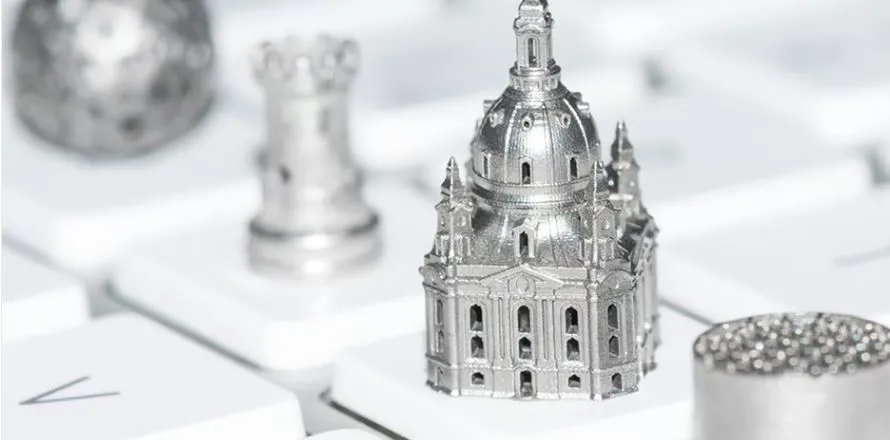 △ Metal 3D micro-printing from 3D MicroPrint
In μSLS, a layer of metallic nanoparticle ink is applied to the substrate and then dried to create a uniform layer of nanoparticles. Next, a digitally micromirrored patterned laser is used to heat the nanoparticles and sinter them into the desired pattern. This set of steps is then repeated to build each layer of the 3D part in the μSLS system.3. Laser Powder Bed Fusion (LPBF)
△ Metal 3D micro-printing from 3D MicroPrint
In μSLS, a layer of metallic nanoparticle ink is applied to the substrate and then dried to create a uniform layer of nanoparticles. Next, a digitally micromirrored patterned laser is used to heat the nanoparticles and sinter them into the desired pattern. This set of steps is then repeated to build each layer of the 3D part in the μSLS system.3. Laser Powder Bed Fusion (LPBF)
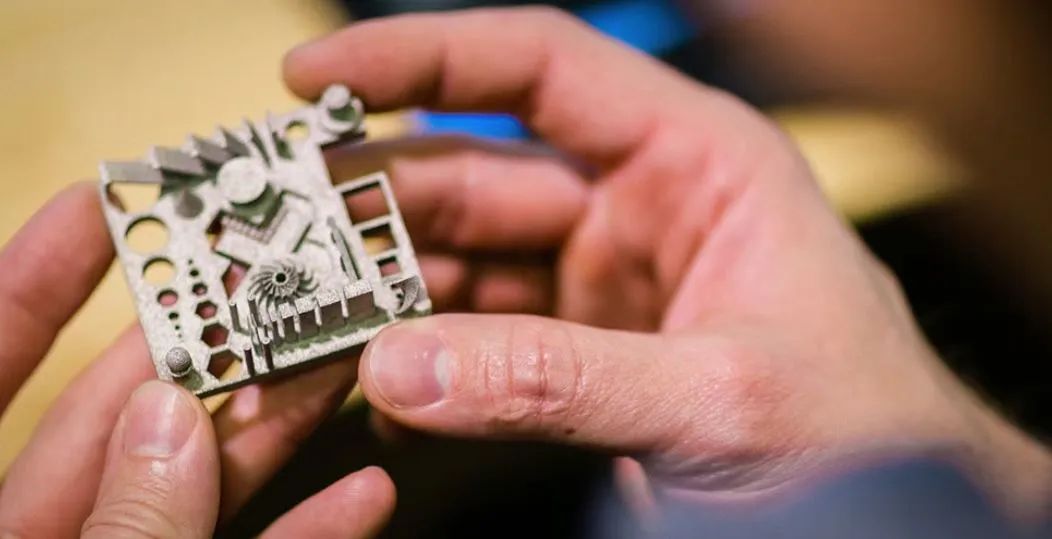 △ Xact Metal test piece demonstrating LPBF precision (Source: Xact Metal)
Among all 3D printing technologies, this one has the most aliases. The formal name for this metal 3D printing method is Laser Powder Bed Fusion (LPBF), which is also widely known as Direct Metal Laser Sintering (DMLS) and Selective Laser Melting (SLM). In the early development of this technology, machine manufacturers created their own names for the same process, which have persisted to this day. It is particularly noted that the above three terms refer to the same process, even though some mechanical details differ.As a subtype of powder bed fusion, LPBF uses a metal powder bed and one or more (up to 12) high-powered lasers. LPBF 3D printers use lasers to selectively fuse metal powder together layer by layer on a molecular basis until the model is complete. LPBF is a highly precise 3D printing method, typically used to create complex metal parts for aerospace, medical, and industrial applications.
△ Xact Metal test piece demonstrating LPBF precision (Source: Xact Metal)
Among all 3D printing technologies, this one has the most aliases. The formal name for this metal 3D printing method is Laser Powder Bed Fusion (LPBF), which is also widely known as Direct Metal Laser Sintering (DMLS) and Selective Laser Melting (SLM). In the early development of this technology, machine manufacturers created their own names for the same process, which have persisted to this day. It is particularly noted that the above three terms refer to the same process, even though some mechanical details differ.As a subtype of powder bed fusion, LPBF uses a metal powder bed and one or more (up to 12) high-powered lasers. LPBF 3D printers use lasers to selectively fuse metal powder together layer by layer on a molecular basis until the model is complete. LPBF is a highly precise 3D printing method, typically used to create complex metal parts for aerospace, medical, and industrial applications.
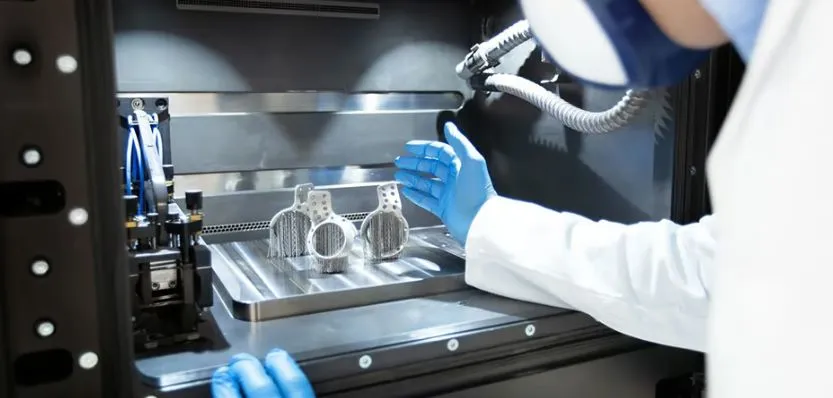 △ LPBF metal 3D printing from Sandvik
Like SLS, LPBF 3D printers start with a digital model divided into slices. The printer loads powder into the build chamber, then spreads it into a thin layer using a scraper (like a windshield wiper) or roller. The laser traces the layer onto the powder. The build platform then moves down, a new layer of powder is applied, and it fuses with the first layer until the entire object is built. The build chamber is closed, sealed, and often filled with an inert gas, such as a nitrogen or argon mixture, to ensure the metal does not oxidize during the melting process and helps clear debris during melting. After printing, parts are removed from the powder bed, cleaned, and often undergo secondary heat treatment to eliminate stress. The remaining powder is recycled for reuse.Differentiating factors for LPBF 3D printers include the type, strength, and number of lasers. A small compact LPBF printer may have a 30-watt laser, while an industrial version may have 12 1,000-watt lasers. LPBF machines use common engineering alloys, such as stainless steel, nickel-based superalloys, and titanium alloys. There are dozens of metals available for the LPBF process.
3. Electron Beam Melting (EBM)
△ LPBF metal 3D printing from Sandvik
Like SLS, LPBF 3D printers start with a digital model divided into slices. The printer loads powder into the build chamber, then spreads it into a thin layer using a scraper (like a windshield wiper) or roller. The laser traces the layer onto the powder. The build platform then moves down, a new layer of powder is applied, and it fuses with the first layer until the entire object is built. The build chamber is closed, sealed, and often filled with an inert gas, such as a nitrogen or argon mixture, to ensure the metal does not oxidize during the melting process and helps clear debris during melting. After printing, parts are removed from the powder bed, cleaned, and often undergo secondary heat treatment to eliminate stress. The remaining powder is recycled for reuse.Differentiating factors for LPBF 3D printers include the type, strength, and number of lasers. A small compact LPBF printer may have a 30-watt laser, while an industrial version may have 12 1,000-watt lasers. LPBF machines use common engineering alloys, such as stainless steel, nickel-based superalloys, and titanium alloys. There are dozens of metals available for the LPBF process.
3. Electron Beam Melting (EBM)
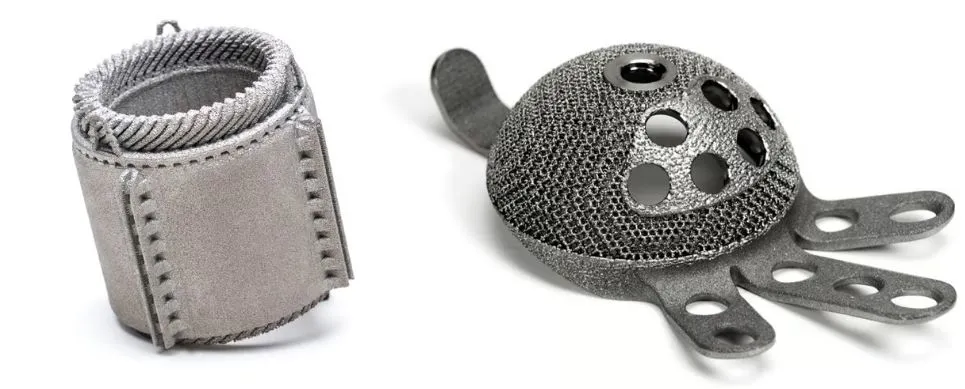 △ Electron Beam Melting (EBM)
EBM, also known as Electron Beam Powder Bed Fusion (EB PBF), is a metal 3D printing method similar to LPBF but uses an electron beam instead of a fiber laser. This technology is used to manufacture parts such as titanium orthopedic implants, turbine blades for jet engines, and copper coils.The electron beam generates more energy and heat, which is required for certain metals and applications. Moreover, EBM is not in an inert gas environment; it operates in a vacuum chamber to prevent the beam from scattering. The build chamber temperature can reach up to 1,000 °C, and in some cases even higher. Because the electron beam uses an electromagnetic beam control, it can move faster than a laser and can even split to expose multiple areas simultaneously.
△ Electron Beam Melting (EBM)
EBM, also known as Electron Beam Powder Bed Fusion (EB PBF), is a metal 3D printing method similar to LPBF but uses an electron beam instead of a fiber laser. This technology is used to manufacture parts such as titanium orthopedic implants, turbine blades for jet engines, and copper coils.The electron beam generates more energy and heat, which is required for certain metals and applications. Moreover, EBM is not in an inert gas environment; it operates in a vacuum chamber to prevent the beam from scattering. The build chamber temperature can reach up to 1,000 °C, and in some cases even higher. Because the electron beam uses an electromagnetic beam control, it can move faster than a laser and can even split to expose multiple areas simultaneously.
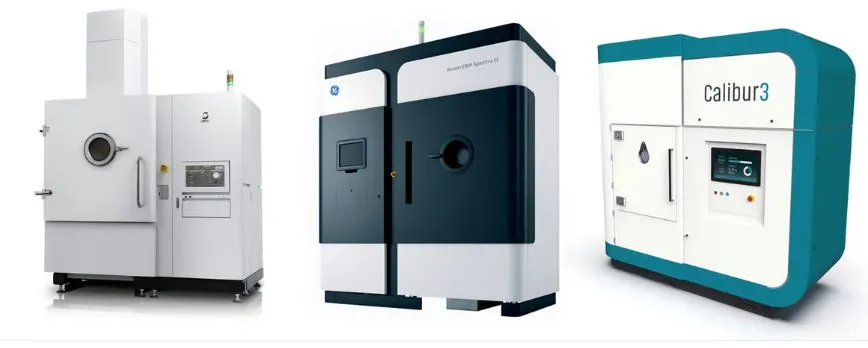 △ Metal 3D printing using an electron beam
One of the advantages of EBM over LPBF is its ability to handle conductive and reflective materials such as copper. Another feature of EBM is the ability to nest or stack individual parts within the build chamber since they do not necessarily have to be connected to the build plate, greatly increasing volume output. EBM-printed parts typically have larger layer thicknesses and rougher surface features than lasers. Due to the high temperature in the build chamber, EBM printed parts may not require post-print heat treatment to eliminate stress.4. Material Jetting
△ Metal 3D printing using an electron beam
One of the advantages of EBM over LPBF is its ability to handle conductive and reflective materials such as copper. Another feature of EBM is the ability to nest or stack individual parts within the build chamber since they do not necessarily have to be connected to the build plate, greatly increasing volume output. EBM-printed parts typically have larger layer thicknesses and rougher surface features than lasers. Due to the high temperature in the build chamber, EBM printed parts may not require post-print heat treatment to eliminate stress.4. Material Jetting
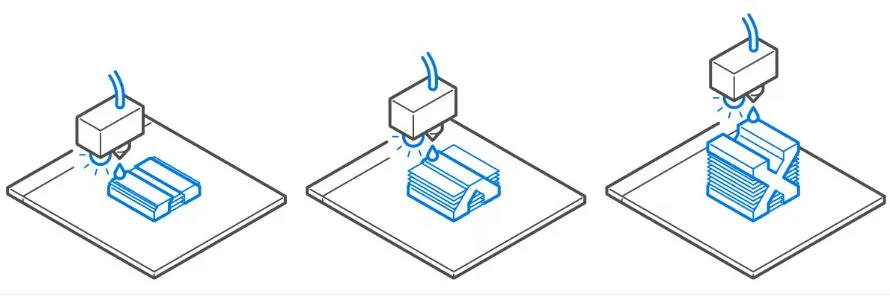 △ Material Jetting
Material jetting is a 3D printing process in which tiny droplets of material are deposited and then cured or solidified on the build plate. Using light-sensitive polymer or wax droplets that cure when exposed to light, objects are built layer by layer. The nature of the material jetting process allows different materials to be printed on the same object. One application of this technology is to produce parts with multiple colors and textures.● Types of 3D printing technologies: Material Jetting (MJ), NanoParticle Jetting (NPJ)● Materials: Photopolymer resins (standard, castable, transparent, high-temperature), wax● Dimensional Accuracy: ±0.1 mm● Common Applications: Full-color product prototypes, prototypes similar to injection molds, low-run injection molds, medical models, fashion● Advantages: Textured surface finish, full-color and multi-material availability● Disadvantages: Limited materials, not suitable for precision mechanical parts, costs higher than other resin technologies for visual purposes1. Material Jetting (M-Jet)
△ Material Jetting
Material jetting is a 3D printing process in which tiny droplets of material are deposited and then cured or solidified on the build plate. Using light-sensitive polymer or wax droplets that cure when exposed to light, objects are built layer by layer. The nature of the material jetting process allows different materials to be printed on the same object. One application of this technology is to produce parts with multiple colors and textures.● Types of 3D printing technologies: Material Jetting (MJ), NanoParticle Jetting (NPJ)● Materials: Photopolymer resins (standard, castable, transparent, high-temperature), wax● Dimensional Accuracy: ±0.1 mm● Common Applications: Full-color product prototypes, prototypes similar to injection molds, low-run injection molds, medical models, fashion● Advantages: Textured surface finish, full-color and multi-material availability● Disadvantages: Limited materials, not suitable for precision mechanical parts, costs higher than other resin technologies for visual purposes1. Material Jetting (M-Jet)
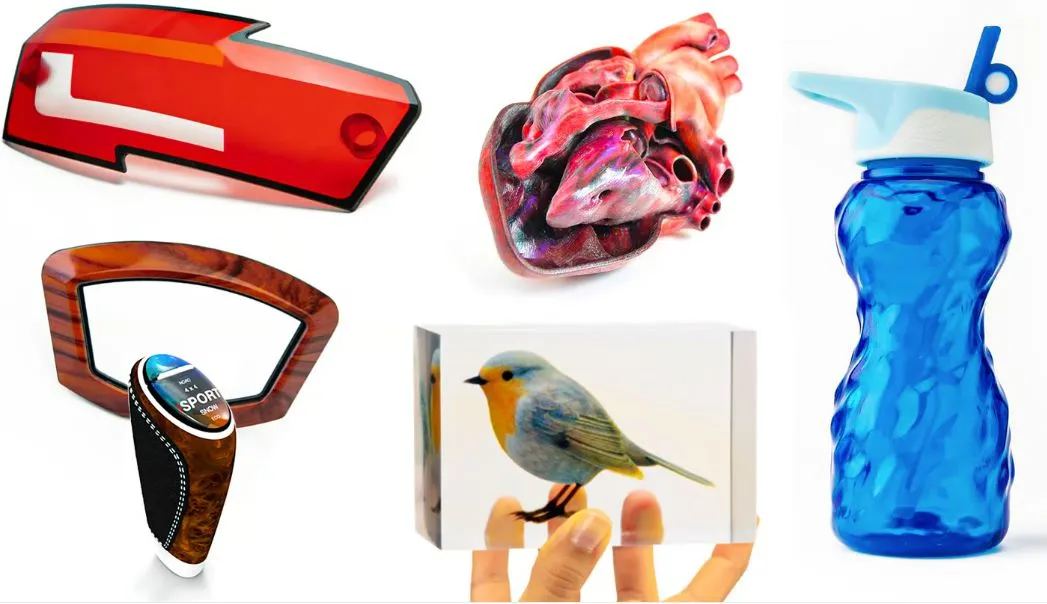 △ Material Jetting 3D printed parts from Stratasys
The polymer material jetting (M-Jet) is a 3D printing process in which a layer of photopolymer resin is selectively deposited onto the build plate and cured with ultraviolet (UV) light. After a layer is deposited and cured, the build platform lowers by one layer thickness, and the process is repeated to build the 3D object. M-Jet combines the high precision of resin 3D printing with the speed of filament 3D printing (FDM) to create parts and prototypes with realistic colors and textures.All material jetting 3D printing technologies are not exactly the same. There are differences between printer manufacturers and proprietary materials. M-Jet machines deposit build materials in a line-by-line manner from multiple rows of print heads. This method allows the printer to manufacture multiple objects in a single line without affecting build speed. As long as the model is correctly arranged on the build platform and optimized for space within each build line, M-Jet can produce parts faster than many other types of resin 3D printers.
△ Material Jetting 3D printed parts from Stratasys
The polymer material jetting (M-Jet) is a 3D printing process in which a layer of photopolymer resin is selectively deposited onto the build plate and cured with ultraviolet (UV) light. After a layer is deposited and cured, the build platform lowers by one layer thickness, and the process is repeated to build the 3D object. M-Jet combines the high precision of resin 3D printing with the speed of filament 3D printing (FDM) to create parts and prototypes with realistic colors and textures.All material jetting 3D printing technologies are not exactly the same. There are differences between printer manufacturers and proprietary materials. M-Jet machines deposit build materials in a line-by-line manner from multiple rows of print heads. This method allows the printer to manufacture multiple objects in a single line without affecting build speed. As long as the model is correctly arranged on the build platform and optimized for space within each build line, M-Jet can produce parts faster than many other types of resin 3D printers.
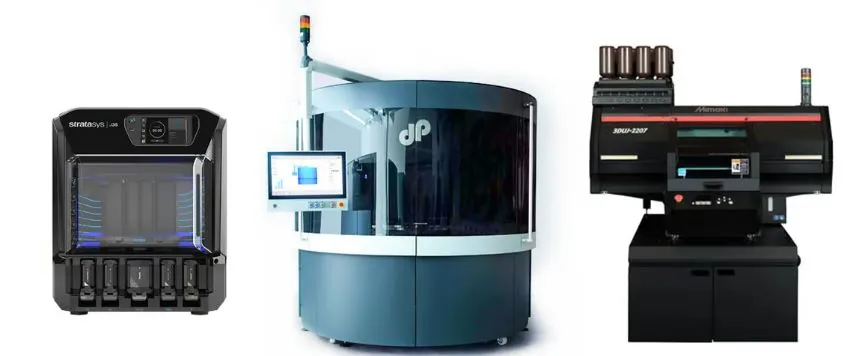 △ Material Jetting 3D printers from Stratasys, DP Polar / 3D Systems, and Mimaki
Objects made with M-Jet require supports, which are printed simultaneously using a dissolvable material that is removed during post-processing. M-Jet is one of the few 3D printing technologies that can produce objects made from multi-material printing and full color. Material jetting machines do not have hobbyist versions; these machines are more suited for professionals in automotive manufacturing, industrial design companies, art studios, hospitals, and all types of product manufacturers who wish to create accurate prototypes to test concepts and bring products to market faster. Unlike barrel polymerization technologies, M-Jet does not require post-curing since the UV light in the printer fully cures each layer.Aerosol JetAerosol Jet is a unique technology developed by a company called Optomec, primarily used for 3D printing electronic products. Components such as resistors, capacitors, antennas, sensors, and thin-film transistors are printed using aerosol jet technology. It can be roughly compared to spray painting, but it differs from industrial coating processes in that it can be used to print complete 3D objects.Electronics ink is placed in an atomizer, which generates droplets with diameters between 1 and 5 microns. The aerosol mist is then delivered to the deposition head, which is focused by sheath gas, resulting in a high-speed particle spray. Since the entire process uses energy, this technology is sometimes referred to as Directed Energy Deposition, but since the material is in droplet form in this case, we include it in material jetting.Plastic Freeform FabricationA technology called Plastic Freeform Fabrication (APF) was created by the German company Arburg, which combines extrusion technology with material jetting technology. It uses commercially available plastic granules that are melted during the injection molding process and moved to the dispensing unit. A high-frequency nozzle opens and closes rapidly to generate up to 200 droplets of plastic with diameters between 0.2 and 0.4 mm per second. The droplets combine with the hardened material as they cool. Generally, no post-processing is needed. If support materials are used, they must be removed.2. NanoParticle Jetting (NPJ)
△ Material Jetting 3D printers from Stratasys, DP Polar / 3D Systems, and Mimaki
Objects made with M-Jet require supports, which are printed simultaneously using a dissolvable material that is removed during post-processing. M-Jet is one of the few 3D printing technologies that can produce objects made from multi-material printing and full color. Material jetting machines do not have hobbyist versions; these machines are more suited for professionals in automotive manufacturing, industrial design companies, art studios, hospitals, and all types of product manufacturers who wish to create accurate prototypes to test concepts and bring products to market faster. Unlike barrel polymerization technologies, M-Jet does not require post-curing since the UV light in the printer fully cures each layer.Aerosol JetAerosol Jet is a unique technology developed by a company called Optomec, primarily used for 3D printing electronic products. Components such as resistors, capacitors, antennas, sensors, and thin-film transistors are printed using aerosol jet technology. It can be roughly compared to spray painting, but it differs from industrial coating processes in that it can be used to print complete 3D objects.Electronics ink is placed in an atomizer, which generates droplets with diameters between 1 and 5 microns. The aerosol mist is then delivered to the deposition head, which is focused by sheath gas, resulting in a high-speed particle spray. Since the entire process uses energy, this technology is sometimes referred to as Directed Energy Deposition, but since the material is in droplet form in this case, we include it in material jetting.Plastic Freeform FabricationA technology called Plastic Freeform Fabrication (APF) was created by the German company Arburg, which combines extrusion technology with material jetting technology. It uses commercially available plastic granules that are melted during the injection molding process and moved to the dispensing unit. A high-frequency nozzle opens and closes rapidly to generate up to 200 droplets of plastic with diameters between 0.2 and 0.4 mm per second. The droplets combine with the hardened material as they cool. Generally, no post-processing is needed. If support materials are used, they must be removed.2. NanoParticle Jetting (NPJ)
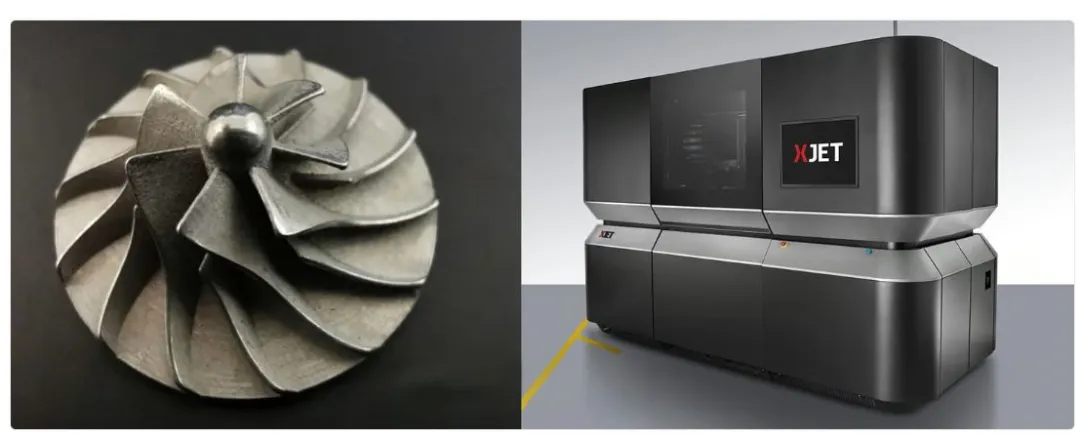 △ Metal parts created using NanoParticle Jetting technology and XJet 3D printers
NanoParticle Jetting (NPJ) is one of the few proprietary technologies that are difficult to classify, developed by a company named XJet. It uses a print head array with thousands of inkjet nozzles to simultaneously jet millions of ultrafine material droplets onto a build tray in ultra-thin layers while simultaneously jetting support material. Metal or ceramic particles are suspended in liquid. The process occurs at high temperatures, and the liquid evaporates during jetting, leaving mostly metal or ceramic material. The resulting 3D parts have only a small amount of binder left, which is removed during the sintering post-processing.5. Binder Jetting
△ Metal parts created using NanoParticle Jetting technology and XJet 3D printers
NanoParticle Jetting (NPJ) is one of the few proprietary technologies that are difficult to classify, developed by a company named XJet. It uses a print head array with thousands of inkjet nozzles to simultaneously jet millions of ultrafine material droplets onto a build tray in ultra-thin layers while simultaneously jetting support material. Metal or ceramic particles are suspended in liquid. The process occurs at high temperatures, and the liquid evaporates during jetting, leaving mostly metal or ceramic material. The resulting 3D parts have only a small amount of binder left, which is removed during the sintering post-processing.5. Binder Jetting
 △ Binder Jetting
Binder jetting is a 3D printing process in which a liquid binder selectively bonds areas of a layer of powder. This type of technology combines characteristics of powder bed fusion and material jetting. Like PBF, binder jetting uses powder materials (metal, plastic, ceramic, wood, sugar, etc.), and like material jetting, liquid binder polymer is deposited from an inkjet. Whether metal, plastic, sand, or other powder materials, the binder jetting process is the same.First, a recoating blade spreads a thin layer of powder on the build platform. Then, a print head with inkjet nozzles passes over the bed, selectively depositing droplets of binder to bond the powder particles together. After the layer is completed, the build platform moves down, and the blade recoats the surface. This process is repeated until the entire part is finished.The uniqueness of binder jetting lies in the absence of heat during the printing process. The binder acts as the glue to bond the polymer powder together. After printing, parts are wrapped in unused powder, which is usually left to cure. The parts are then removed from the powder chamber, excess powder is collected, and can be reused. From here, post-processing may be required depending on the material, but sand can usually be used directly from the printer as cores or molds. When the powder is metal or ceramic, post-processing involving heating will melt away the binder, leaving metal behind. Post-processing for plastic parts typically includes coating to improve surface finish. You can also polish, paint, and sand polymer binder jetted parts.Binder jetting is fast and highly productive, making it a more economical way to produce large quantities of parts compared to other AM methods. Metal binder jetting is popular for various metals in end-use consumer goods, tools, and batch spare parts. However, polymer binder jetting has limited material choices and the structural performance of the produced parts is lower. Its value lies in the ability to create full-color prototypes and models.● Subtypes of 3D printing technology: Metal Binder Jetting, Polymer Binder Jetting, Sand Binder Jetting● Materials: Sand, Polymers, Metals, Ceramics, etc.● Dimensional Accuracy: ±0.2 mm (metal) or ±0.3 mm (sand)● Common Applications: Functional metal parts, full-color models, sand castings, and molds● Advantages: Low cost, large build volume, functional metal parts, excellent color reproduction, fast printing speed, support-free design flexibility● Disadvantages: A multi-step process for metals, polymer parts are not durable1. Metal Binder Jetting
△ Binder Jetting
Binder jetting is a 3D printing process in which a liquid binder selectively bonds areas of a layer of powder. This type of technology combines characteristics of powder bed fusion and material jetting. Like PBF, binder jetting uses powder materials (metal, plastic, ceramic, wood, sugar, etc.), and like material jetting, liquid binder polymer is deposited from an inkjet. Whether metal, plastic, sand, or other powder materials, the binder jetting process is the same.First, a recoating blade spreads a thin layer of powder on the build platform. Then, a print head with inkjet nozzles passes over the bed, selectively depositing droplets of binder to bond the powder particles together. After the layer is completed, the build platform moves down, and the blade recoats the surface. This process is repeated until the entire part is finished.The uniqueness of binder jetting lies in the absence of heat during the printing process. The binder acts as the glue to bond the polymer powder together. After printing, parts are wrapped in unused powder, which is usually left to cure. The parts are then removed from the powder chamber, excess powder is collected, and can be reused. From here, post-processing may be required depending on the material, but sand can usually be used directly from the printer as cores or molds. When the powder is metal or ceramic, post-processing involving heating will melt away the binder, leaving metal behind. Post-processing for plastic parts typically includes coating to improve surface finish. You can also polish, paint, and sand polymer binder jetted parts.Binder jetting is fast and highly productive, making it a more economical way to produce large quantities of parts compared to other AM methods. Metal binder jetting is popular for various metals in end-use consumer goods, tools, and batch spare parts. However, polymer binder jetting has limited material choices and the structural performance of the produced parts is lower. Its value lies in the ability to create full-color prototypes and models.● Subtypes of 3D printing technology: Metal Binder Jetting, Polymer Binder Jetting, Sand Binder Jetting● Materials: Sand, Polymers, Metals, Ceramics, etc.● Dimensional Accuracy: ±0.2 mm (metal) or ±0.3 mm (sand)● Common Applications: Functional metal parts, full-color models, sand castings, and molds● Advantages: Low cost, large build volume, functional metal parts, excellent color reproduction, fast printing speed, support-free design flexibility● Disadvantages: A multi-step process for metals, polymer parts are not durable1. Metal Binder Jetting
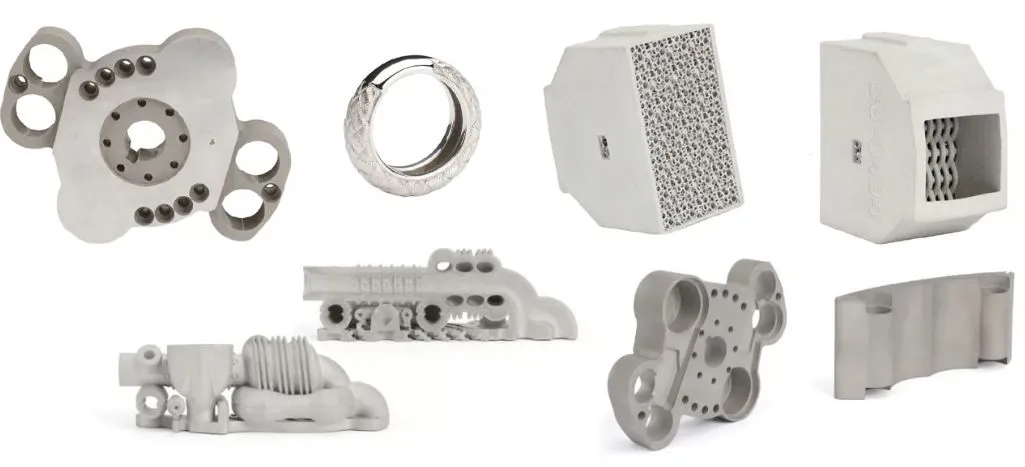 △ Stainless steel 3D printed parts using metal jetting technology from HP
Metal binder jetting can also be used to manufacture solid metal objects with complex geometries that far exceed the capabilities of traditional manufacturing techniques. Metal binder jetting is a very attractive technology for mass-producing metal parts and achieving lightweight designs. Since binder jetting can print parts with complex pattern fill instead of solid parts, the resulting parts are significantly lighter while maintaining strength. The porosity characteristics of binder jetting can also be used to achieve lighter end parts for medical applications, such as implants.Overall, the material properties of metal binder jetted parts are comparable to those of metal parts produced by metal injection molding, making it one of the most widely used manufacturing methods for mass production of metal parts. Additionally, binder jetting parts exhibit higher surface smoothness, especially in internal channels.
△ Stainless steel 3D printed parts using metal jetting technology from HP
Metal binder jetting can also be used to manufacture solid metal objects with complex geometries that far exceed the capabilities of traditional manufacturing techniques. Metal binder jetting is a very attractive technology for mass-producing metal parts and achieving lightweight designs. Since binder jetting can print parts with complex pattern fill instead of solid parts, the resulting parts are significantly lighter while maintaining strength. The porosity characteristics of binder jetting can also be used to achieve lighter end parts for medical applications, such as implants.Overall, the material properties of metal binder jetted parts are comparable to those of metal parts produced by metal injection molding, making it one of the most widely used manufacturing methods for mass production of metal parts. Additionally, binder jetting parts exhibit higher surface smoothness, especially in internal channels.
 △ Metal binder jetting 3D printers produce fine solid metal parts for end-use applications
Metal binder jetting parts require secondary processing after printing to achieve good mechanical properties. Just out of the printer, the parts are basically composed of metal particles glued together with a polymer binder. These so-called “green parts” are fragile and cannot be used as-is. After parts are removed from the metal powder bed (a process called depowdering), they are subjected to heat treatment in a furnace (a process called sintering). Both the printing parameters and the sintering parameters are adjusted for the specific part geometry, material, and desired density. Sometimes bronze or other metals are used to infiltrate the voids in the binder jetted parts to achieve zero porosity.2. Plastic Binder Jetting
△ Metal binder jetting 3D printers produce fine solid metal parts for end-use applications
Metal binder jetting parts require secondary processing after printing to achieve good mechanical properties. Just out of the printer, the parts are basically composed of metal particles glued together with a polymer binder. These so-called “green parts” are fragile and cannot be used as-is. After parts are removed from the metal powder bed (a process called depowdering), they are subjected to heat treatment in a furnace (a process called sintering). Both the printing parameters and the sintering parameters are adjusted for the specific part geometry, material, and desired density. Sometimes bronze or other metals are used to infiltrate the voids in the binder jetted parts to achieve zero porosity.2. Plastic Binder Jetting
 △ Plastic Binder Jetting
Plastic binder jetting is a process very similar to metal binder jetting, as it also uses powder and liquid binder, but the applications are vastly different. Once printed, plastic parts are removed from their powder bed and cleaned, typically ready for use without further processing, but these parts lack strength and durability found in 3D printing processes. Plastic binder jetted parts can be filled with another material to enhance strength. The use of polymers for binder jetting is due to their ability to produce multicolor parts for medical modeling and product prototyping.3. Sand Binder Jetting
△ Plastic Binder Jetting
Plastic binder jetting is a process very similar to metal binder jetting, as it also uses powder and liquid binder, but the applications are vastly different. Once printed, plastic parts are removed from their powder bed and cleaned, typically ready for use without further processing, but these parts lack strength and durability found in 3D printing processes. Plastic binder jetted parts can be filled with another material to enhance strength. The use of polymers for binder jetting is due to their ability to produce multicolor parts for medical modeling and product prototyping.3. Sand Binder Jetting
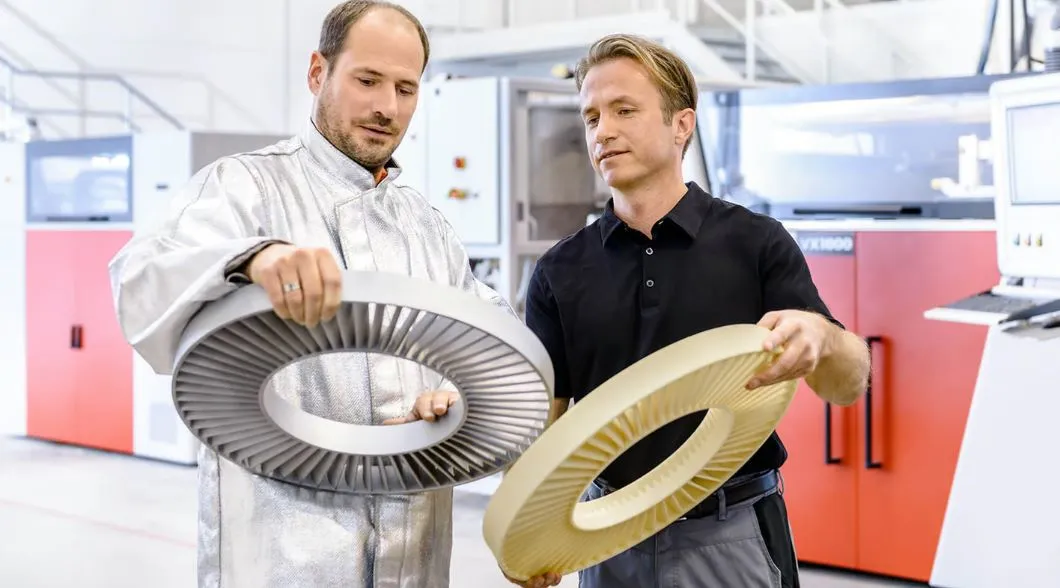 △ Sand Binder Jetting
Sand binder jetting differs from plastic binder jetting in terms of printer and printing process, so it is distinguished here. One of the most common uses of binder jetting technology is to produce large sand casting molds, models, and cores. The low cost and speed of this process make it an excellent solution for foundries, as it is difficult to produce finely patterned designs within hours using traditional techniques.The future of industrial development continues to place high demands on contract factories and suppliers. Sand 3D printing is at the beginning of its potential. After printing, operators need to remove and clean the cores and molds from the build area to remove any loose sand. Molds can usually be immediately prepared for casting. After casting, the molds are dismantled, and the final metal parts are removed.4. Multi Jet Fusion (MJF)
△ Sand Binder Jetting
Sand binder jetting differs from plastic binder jetting in terms of printer and printing process, so it is distinguished here. One of the most common uses of binder jetting technology is to produce large sand casting molds, models, and cores. The low cost and speed of this process make it an excellent solution for foundries, as it is difficult to produce finely patterned designs within hours using traditional techniques.The future of industrial development continues to place high demands on contract factories and suppliers. Sand 3D printing is at the beginning of its potential. After printing, operators need to remove and clean the cores and molds from the build area to remove any loose sand. Molds can usually be immediately prepared for casting. After casting, the molds are dismantled, and the final metal parts are removed.4. Multi Jet Fusion (MJF)
 △ BASF and HP collaborated to develop a new industrial-grade polypropylene for MJF
Another unique and brand-specific 3D printing process is not easily categorized into any existing category; it is not actually binder jetting, which is HP’s Multi Jet Fusion. MJF is a polymer 3D printing technology that uses powder materials, liquid fusion materials, and detailing agents. It is not considered binder jetting because heat is added to the process, resulting in parts with higher strength and durability, and the liquid is not entirely a binder. The name of the process comes from the multiple print heads executing the printing process.In the Multi Jet Fusion printing process, the printer lays down a layer of powder material, usually nylon. After this, the print heads pass through the powder and deposit fusion agents and detailing agents on it. An infrared heating device then moves over the printed item. Wherever the fusion agent is added, the lower layer fuses together, while the areas with detailing agents remain powdery. The powdery portions fall away, creating the desired geometry. This also eliminates the need for modeling support since the lower layer supports the layers printed above it. To complete the printing process, the entire powder bed and the printed parts within it are moved to a separate processing station, where most of the loose un-fused powder is vacuumed and can be reused.Multi Jet Fusion is a versatile technology that has been applied across multiple industries, including automotive, healthcare, and consumer goods.
6. Powder Directed Energy DepositionDirected Energy Deposition (DED) is a 3D printing process where metal materials are supplied and melted while being deposited. This is one of the broadest categories of 3D printing, containing many subcategories depending on the form of the material (wire or powder) and the type of energy (laser, electron beam, arc, supersonic, heat, etc.). Essentially, it shares many commonalities with welding.This technology is used for layer-by-layer printing, often followed by CNC machining to achieve tighter tolerances. The combination of DED with CNC is very common, with a subtype of 3D printing called hybrid 3D printing that includes both DED and CNC units within the same machine. This technology is considered a faster and cheaper alternative for small batch metal castings and forgings, as well as key repairs for applications in the offshore oil and gas industry, aerospace, power generation, and utilities.
△ BASF and HP collaborated to develop a new industrial-grade polypropylene for MJF
Another unique and brand-specific 3D printing process is not easily categorized into any existing category; it is not actually binder jetting, which is HP’s Multi Jet Fusion. MJF is a polymer 3D printing technology that uses powder materials, liquid fusion materials, and detailing agents. It is not considered binder jetting because heat is added to the process, resulting in parts with higher strength and durability, and the liquid is not entirely a binder. The name of the process comes from the multiple print heads executing the printing process.In the Multi Jet Fusion printing process, the printer lays down a layer of powder material, usually nylon. After this, the print heads pass through the powder and deposit fusion agents and detailing agents on it. An infrared heating device then moves over the printed item. Wherever the fusion agent is added, the lower layer fuses together, while the areas with detailing agents remain powdery. The powdery portions fall away, creating the desired geometry. This also eliminates the need for modeling support since the lower layer supports the layers printed above it. To complete the printing process, the entire powder bed and the printed parts within it are moved to a separate processing station, where most of the loose un-fused powder is vacuumed and can be reused.Multi Jet Fusion is a versatile technology that has been applied across multiple industries, including automotive, healthcare, and consumer goods.
6. Powder Directed Energy DepositionDirected Energy Deposition (DED) is a 3D printing process where metal materials are supplied and melted while being deposited. This is one of the broadest categories of 3D printing, containing many subcategories depending on the form of the material (wire or powder) and the type of energy (laser, electron beam, arc, supersonic, heat, etc.). Essentially, it shares many commonalities with welding.This technology is used for layer-by-layer printing, often followed by CNC machining to achieve tighter tolerances. The combination of DED with CNC is very common, with a subtype of 3D printing called hybrid 3D printing that includes both DED and CNC units within the same machine. This technology is considered a faster and cheaper alternative for small batch metal castings and forgings, as well as key repairs for applications in the offshore oil and gas industry, aerospace, power generation, and utilities.
 △ DED metal 3D printing technology can quickly create a robust metal part, which can then be machined to strict tolerances
● Subtypes of Directed Energy Deposition: Powder Laser Energy Deposition, Wire Arc Additive Manufacturing (WAAM), Wire Electron Beam Energy Deposition, Cold Spray● Materials: Various metals in wire and powder form● Dimensional Accuracy: ±0.1 mm● Common Applications: Repairing high-end automotive/aerospace components, functional prototypes, and end parts● Advantages: High deposition rate, ability to add metal to existing components● Disadvantages: Unable to create complex shapes due to the lack of support structures, typically poorer surface finish and accuracy1. Laser Directed Energy Deposition
△ DED metal 3D printing technology can quickly create a robust metal part, which can then be machined to strict tolerances
● Subtypes of Directed Energy Deposition: Powder Laser Energy Deposition, Wire Arc Additive Manufacturing (WAAM), Wire Electron Beam Energy Deposition, Cold Spray● Materials: Various metals in wire and powder form● Dimensional Accuracy: ±0.1 mm● Common Applications: Repairing high-end automotive/aerospace components, functional prototypes, and end parts● Advantages: High deposition rate, ability to add metal to existing components● Disadvantages: Unable to create complex shapes due to the lack of support structures, typically poorer surface finish and accuracy1. Laser Directed Energy Deposition
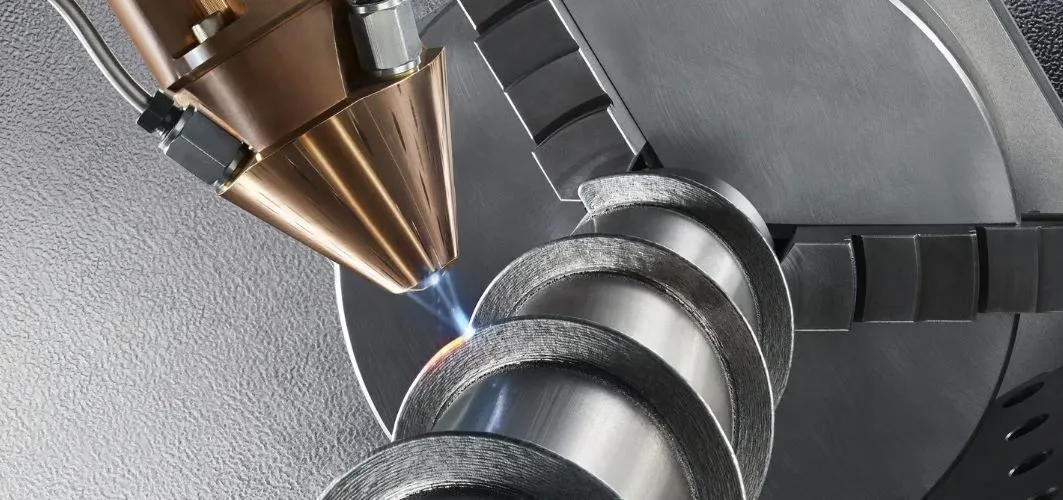 △ 3D printing metal using laser and powder
Laser Directed Energy Deposition (L-DED), also known as Laser Metal Deposition (LMD) or Laser Engineering Net Shaping (LENS), uses metal powder or wire fed through one or more nozzles and melted onto a build platform or metal part with a powerful laser. As the nozzle and laser move or the part moves on a multi-axis turntable, the object is built layer by layer. The build speed is faster than powder bed melting, but it results in lower surface quality and significantly reduced accuracy, often requiring extensive post-processing. Laser DED printers typically have sealed chambers filled with argon to avoid oxidation. They can also operate using only localized argon or nitrogen when dealing with less reactive metals.Common metals used in this process include stainless steel, titanium, and nickel alloys. This printing method is typically used to repair high-end aerospace and automotive components, such as jet engine blades, but is also used to produce entire parts.
2. Electron Beam Directed Energy Deposition
△ 3D printing metal using laser and powder
Laser Directed Energy Deposition (L-DED), also known as Laser Metal Deposition (LMD) or Laser Engineering Net Shaping (LENS), uses metal powder or wire fed through one or more nozzles and melted onto a build platform or metal part with a powerful laser. As the nozzle and laser move or the part moves on a multi-axis turntable, the object is built layer by layer. The build speed is faster than powder bed melting, but it results in lower surface quality and significantly reduced accuracy, often requiring extensive post-processing. Laser DED printers typically have sealed chambers filled with argon to avoid oxidation. They can also operate using only localized argon or nitrogen when dealing with less reactive metals.Common metals used in this process include stainless steel, titanium, and nickel alloys. This printing method is typically used to repair high-end aerospace and automotive components, such as jet engine blades, but is also used to produce entire parts.
2. Electron Beam Directed Energy Deposition
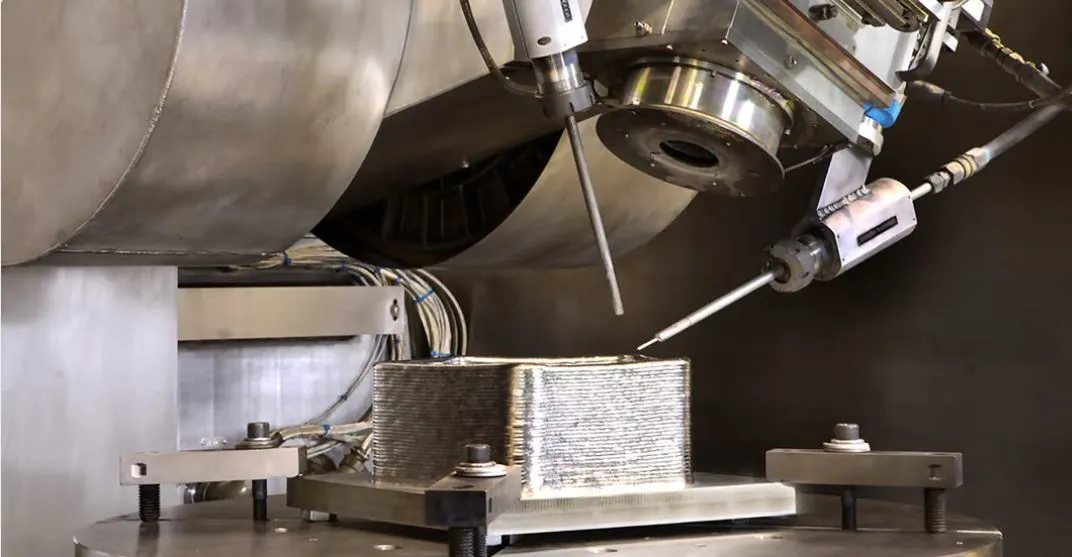 △ Electron Beam DED 3D printing
Electron Beam DED, also known as Wire Electron Beam Energy Deposition, is a 3D printing process very similar to Laser DED. It is conducted in a vacuum chamber and can produce very clean, high-quality metals. As a metal wire is fed through one or more nozzles, it is melted by an electron beam. Layers are built individually, with the electron beam forming a small melt pool, into which the wire is fed by a wire feeder. The electron beam is chosen for DED when working with high-performance and reactive metals (such as copper, titanium, cobalt, and nickel alloys).DED machines are practically unlimited in size for printing. For example, 3D printer manufacturer Sciaky has an EB DED machine capable of producing nearly 6-meter-long parts at a rate of 3 to 9 kg of material per hour. Electron beam DED is touted as one of the fastest methods for manufacturing metal parts, although not the most precise, making it ideal for building large structures (such as fuselages) or replacement parts (such as turbine blades).
3. Wire Directed Energy Deposition
△ Electron Beam DED 3D printing
Electron Beam DED, also known as Wire Electron Beam Energy Deposition, is a 3D printing process very similar to Laser DED. It is conducted in a vacuum chamber and can produce very clean, high-quality metals. As a metal wire is fed through one or more nozzles, it is melted by an electron beam. Layers are built individually, with the electron beam forming a small melt pool, into which the wire is fed by a wire feeder. The electron beam is chosen for DED when working with high-performance and reactive metals (such as copper, titanium, cobalt, and nickel alloys).DED machines are practically unlimited in size for printing. For example, 3D printer manufacturer Sciaky has an EB DED machine capable of producing nearly 6-meter-long parts at a rate of 3 to 9 kg of material per hour. Electron beam DED is touted as one of the fastest methods for manufacturing metal parts, although not the most precise, making it ideal for building large structures (such as fuselages) or replacement parts (such as turbine blades).
3. Wire Directed Energy Deposition
 △ Gefertec arc additive manufacturing (WAAM) printing
Wire Directed Energy Deposition, also known as Wire Arc Additive Manufacturing (WAAM), is a 3D printing process that uses energy in the form of plasma or arc to melt metal in wire form and deposit it layer by layer onto a surface, such as a multi-axis turntable, to form a shape. The reason for choosing this method over similar techniques using lasers or electron beams is that it does not require a sealed chamber and can use the same metals as traditional welding (sometimes the exact same materials).Direct energy deposition is considered the most cost-effective choice among DED technologies, as it can use existing arc welding robots and power supplies, making the entry barrier relatively low. However, unlike welding, this technology uses complex software to control a range of variables during the process, including thermal management of the robotic arm and tool paths. This technology does not require support structures to be removed, and finished parts are often CNC machined as necessary to achieve strict tolerances or surface polishing.
△ Gefertec arc additive manufacturing (WAAM) printing
Wire Directed Energy Deposition, also known as Wire Arc Additive Manufacturing (WAAM), is a 3D printing process that uses energy in the form of plasma or arc to melt metal in wire form and deposit it layer by layer onto a surface, such as a multi-axis turntable, to form a shape. The reason for choosing this method over similar techniques using lasers or electron beams is that it does not require a sealed chamber and can use the same metals as traditional welding (sometimes the exact same materials).Direct energy deposition is considered the most cost-effective choice among DED technologies, as it can use existing arc welding robots and power supplies, making the entry barrier relatively low. However, unlike welding, this technology uses complex software to control a range of variables during the process, including thermal management of the robotic arm and tool paths. This technology does not require support structures to be removed, and finished parts are often CNC machined as necessary to achieve strict tolerances or surface polishing.
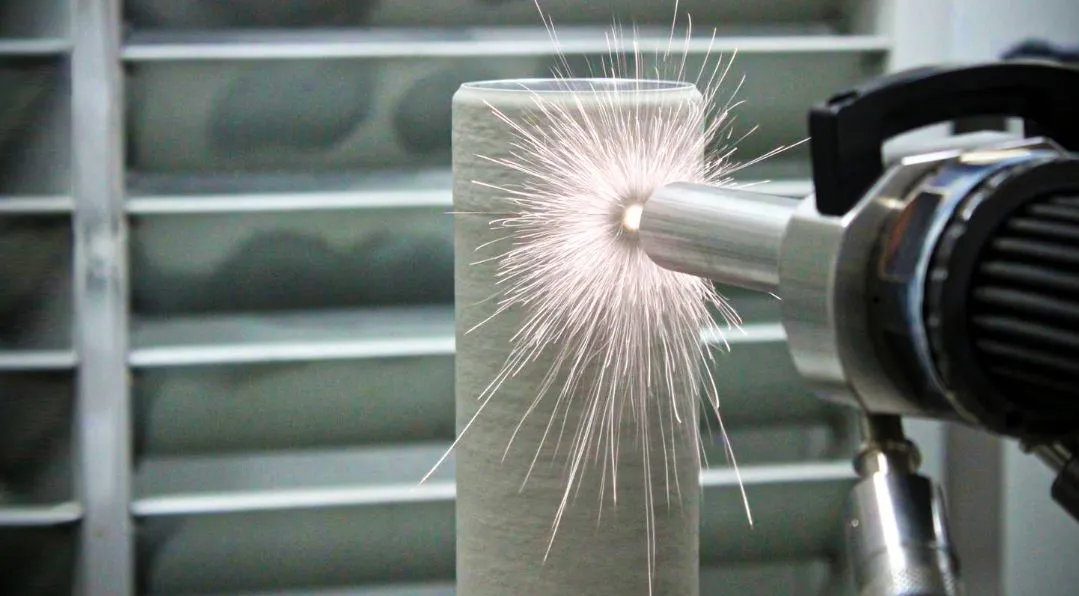 △ Cold Spray
Cold spray is a DED 3D printing technology that uses supersonic spraying of metal powders to bond them together without melting, producing almost no thermal cracks or thermal stress. Since the early 2000s, it has been used as a coating process, but recently, several companies have begun using cold spray for additive manufacturing because it can print at speeds 50 to 100 times higher than typical metal 3D processes and does not require inert gas or vacuum chambers.Like all DED processes, cold spray does not produce parts with good surface quality or detail, but parts can be used directly from the print bed.5. Melted Direct Energy Deposition
△ Cold Spray
Cold spray is a DED 3D printing technology that uses supersonic spraying of metal powders to bond them together without melting, producing almost no thermal cracks or thermal stress. Since the early 2000s, it has been used as a coating process, but recently, several companies have begun using cold spray for additive manufacturing because it can print at speeds 50 to 100 times higher than typical metal 3D processes and does not require inert gas or vacuum chambers.Like all DED processes, cold spray does not produce parts with good surface quality or detail, but parts can be used directly from the print bed.5. Melted Direct Energy Deposition
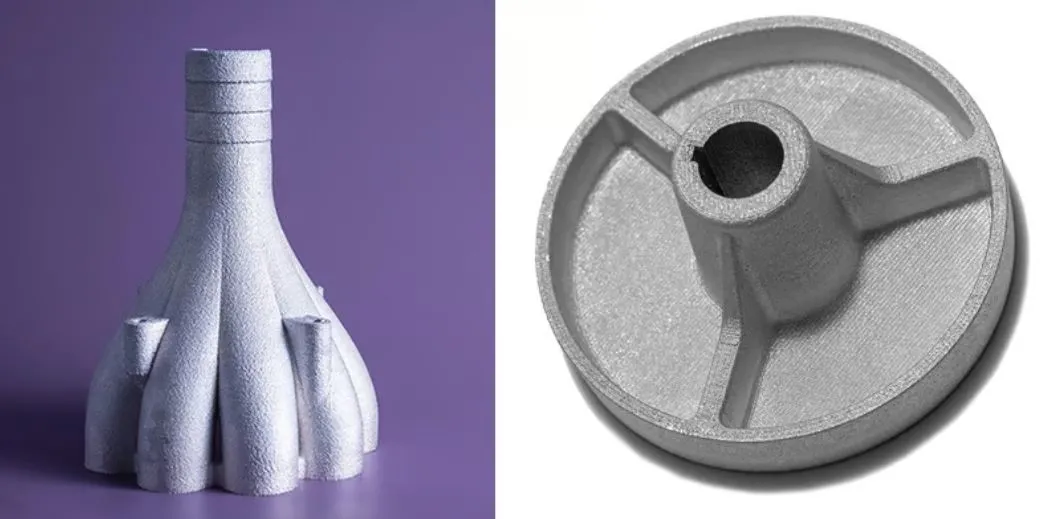 △ Melted Direct Energy Deposition: Aluminum parts made using Xerox’s ElemX 3D liquid metal printer
Melted direct energy deposition is a 3D printing process that uses heat to melt metal (usually aluminum) and then deposits it layer by layer on a build plate to form 3D objects. This technology differs from metal extrusion 3D printing in that extrusion uses a metal feedstock containing a small amount of polymer to make the metal extrudable. The polymer is then removed during the heat treatment phase, while melted DED uses pure metal. Melted or liquid DED can also be likened to material jetting, but instead of a series of nozzles depositing droplets, liquid metal typically flows out of a nozzle.Variants of this technology are under development, and melted metal 3D printers are rare. The benefit of using heat to melt and then deposit metal is the ability to use less energy than other DED processes and potentially use recycled metal directly as feedstock instead of metal wire or highly processed metal powder.7. Sheet Lamination
△ Melted Direct Energy Deposition: Aluminum parts made using Xerox’s ElemX 3D liquid metal printer
Melted direct energy deposition is a 3D printing process that uses heat to melt metal (usually aluminum) and then deposits it layer by layer on a build plate to form 3D objects. This technology differs from metal extrusion 3D printing in that extrusion uses a metal feedstock containing a small amount of polymer to make the metal extrudable. The polymer is then removed during the heat treatment phase, while melted DED uses pure metal. Melted or liquid DED can also be likened to material jetting, but instead of a series of nozzles depositing droplets, liquid metal typically flows out of a nozzle.Variants of this technology are under development, and melted metal 3D printers are rare. The benefit of using heat to melt and then deposit metal is the ability to use less energy than other DED processes and potentially use recycled metal directly as feedstock instead of metal wire or highly processed metal powder.7. Sheet Lamination
 △ Sheet Lamination
Sheet lamination is technically a form of 3D printing that is very different from the above technologies. Its function is to stack and laminate very thin sheets of material together to produce 3D objects or stacks, which are then cut into the final shape using mechanical or laser cutting. The material layers can be fused together using various methods, including heating and sound, depending on the material, which ranges from paper, polymers to metals. When parts are laminated and then laser cut or machined into the desired shape, more waste is produced compared to other 3D printing technologies.Manufacturers use sheet lamination to produce cost-effective non-functional prototypes at relatively high speeds, which can be used in battery technology and composite material production, as the materials used can be interchanged during printing.● Types of 3D printing technologies: Laminated Object Manufacturing (LOM), Ultrasonic Consolidation (UC)● Materials: Paper, polymers, and sheet metals● Dimensional Accuracy: ±0.1 mm● Common Applications: Non-functional prototypes, multicolor printing, molds.● Advantages: Can be produced quickly, composite printing● Disadvantages: Low precision, high waste, some parts require post-processingLaminated Additive Manufacturing
△ Sheet Lamination
Sheet lamination is technically a form of 3D printing that is very different from the above technologies. Its function is to stack and laminate very thin sheets of material together to produce 3D objects or stacks, which are then cut into the final shape using mechanical or laser cutting. The material layers can be fused together using various methods, including heating and sound, depending on the material, which ranges from paper, polymers to metals. When parts are laminated and then laser cut or machined into the desired shape, more waste is produced compared to other 3D printing technologies.Manufacturers use sheet lamination to produce cost-effective non-functional prototypes at relatively high speeds, which can be used in battery technology and composite material production, as the materials used can be interchanged during printing.● Types of 3D printing technologies: Laminated Object Manufacturing (LOM), Ultrasonic Consolidation (UC)● Materials: Paper, polymers, and sheet metals● Dimensional Accuracy: ±0.1 mm● Common Applications: Non-functional prototypes, multicolor printing, molds.● Advantages: Can be produced quickly, composite printing● Disadvantages: Low precision, high waste, some parts require post-processingLaminated Additive Manufacturing
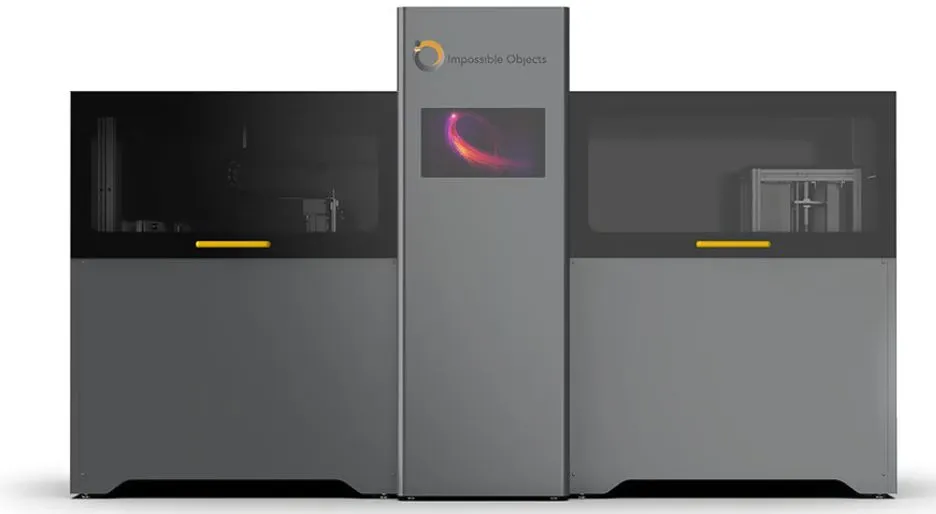 △ Laminated Additive Manufacturing
Lamination is a 3D printing technology where material sheets are stacked together and bonded with glue, then cut (or laser cut or CNC routed) into the correct shape. This technology is now less common as the costs of other 3D printing technologies have decreased, and the speed and ease of use have increased significantly.
△ Laminated Additive Manufacturing
Lamination is a 3D printing technology where material sheets are stacked together and bonded with glue, then cut (or laser cut or CNC routed) into the correct shape. This technology is now less common as the costs of other 3D printing technologies have decreased, and the speed and ease of use have increased significantly.
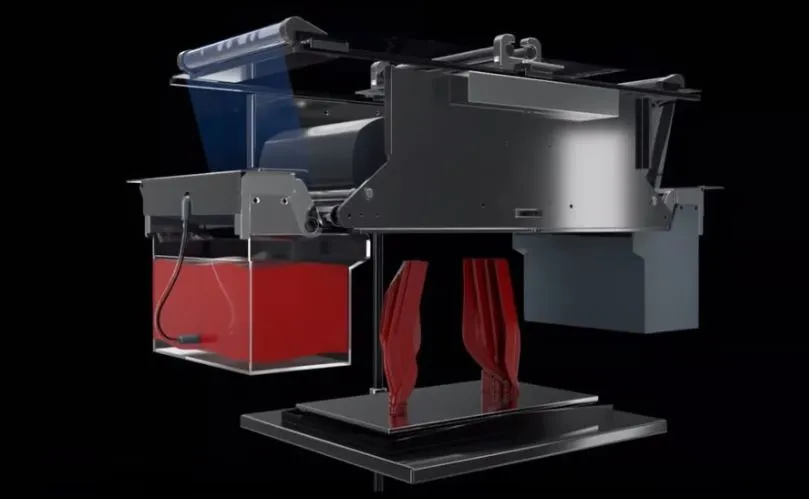 △ BCN3D’s Viscous Lithography Manufacturing (VLM) 3D printing process using resin (Source: BCN3D)
Viscous Lithography Manufacturing (VLM): VLM is a proprietary 3D printing technology from BCN3D that layers high-viscosity photosensitive resin onto a transparent transfer film. The mechanical system allows the resin to be laminated from both sides of the film, enabling the combination of different resins for multi-material parts and easily removable support structures. This technology has not yet been commercialized, but it could also belong to one of the laminated 3D printing technologies.Composite-based Additive Manufacturing (CBAM): Startup Impossible Objects has patented this technology, which fuses carbon, glass, or Kevlar mats with thermoplastics to manufacture parts.Selective Laminate Composite Manufacturing (SLCOM): EnvisionTEC, now owned by ETEC and part of Desktop Metal, developed this technology in 2016, which uses thermoplastic plastics as the base material and woven fiber composites.Note: There are many types of 3D printing technologies, and the above are the seven most common types of additive manufacturing technologies in 3D printing, which do not cover all 3D printing technologies available on the market.
△ BCN3D’s Viscous Lithography Manufacturing (VLM) 3D printing process using resin (Source: BCN3D)
Viscous Lithography Manufacturing (VLM): VLM is a proprietary 3D printing technology from BCN3D that layers high-viscosity photosensitive resin onto a transparent transfer film. The mechanical system allows the resin to be laminated from both sides of the film, enabling the combination of different resins for multi-material parts and easily removable support structures. This technology has not yet been commercialized, but it could also belong to one of the laminated 3D printing technologies.Composite-based Additive Manufacturing (CBAM): Startup Impossible Objects has patented this technology, which fuses carbon, glass, or Kevlar mats with thermoplastics to manufacture parts.Selective Laminate Composite Manufacturing (SLCOM): EnvisionTEC, now owned by ETEC and part of Desktop Metal, developed this technology in 2016, which uses thermoplastic plastics as the base material and woven fiber composites.Note: There are many types of 3D printing technologies, and the above are the seven most common types of additive manufacturing technologies in 3D printing, which do not cover all 3D printing technologies available on the market.
For submissions, please click “Read the original text”

Responsible Editor: Duan Shaomin
Reviewed by: Li Guoqing
Source:Nanji Xiong 3D Printing, if there are copyright issues, please contact us in a timely manner. The interpretation of copyright belongs to the original author, and this article is recommended by Intelligent Manufacturing IMS!


Pleasefollowthe video account
to learn more about intelligent manufacturing news
 △ Material Extrusion 3D Printing
△ Material Extrusion 3D Printing △ FDM parts can be made from metal or plastic on various 3D printers
△ FDM parts can be made from metal or plastic on various 3D printers △ FDM 3D printers offer a wide range of machines for hobbyists, small businesses, and manufacturers (Source: Creality, Raise3D, Stratasys)
△ FDM 3D printers offer a wide range of machines for hobbyists, small businesses, and manufacturers (Source: Creality, Raise3D, Stratasys) △ 3D Bio-printing is similar to traditional 3D printing, but with significant differences in materials
△ 3D Bio-printing is similar to traditional 3D printing, but with significant differences in materials △ Construction 3D Printing
△ Construction 3D Printing △ Photopolymerization using lasers
△ Photopolymerization using lasers △ Large barrel polymerization utilizes light to cure photosensitive resin layer by layer
△ Large barrel polymerization utilizes light to cure photosensitive resin layer by layer △ SLA 3D printing examples from 3D Systems, DWS, and Formlabs
△ SLA 3D printing examples from 3D Systems, DWS, and Formlabs △ SLA 3D printers use one or more lasers to trace and cure a single layer of resin at a time
△ SLA 3D printers use one or more lasers to trace and cure a single layer of resin at a time △ Nanoscribe and Microlight3D are two leading manufacturers of TPP 3D printers (Source: Nanoscribe, Microlight3D)
△ Nanoscribe and Microlight3D are two leading manufacturers of TPP 3D printers (Source: Nanoscribe, Microlight3D) △ DLP 3D printed parts from Anycubic, Carbon, and ETEC
△ DLP 3D printed parts from Anycubic, Carbon, and ETEC △ Digital Light Processing (DLP) resin 3D printers come in hobbyist versions and full manufacturing production machines
△ Digital Light Processing (DLP) resin 3D printers come in hobbyist versions and full manufacturing production machines △ LCD 3D printed parts from Elegoo, Photocentric, and Nexa3D
△ LCD 3D printed parts from Elegoo, Photocentric, and Nexa3D △ Today, LCD resin 3D printing technology is shifting from consumer machines to industrial machines
△ Today, LCD resin 3D printing technology is shifting from consumer machines to industrial machines △ Powder Bed Fusion
△ Powder Bed Fusion △ Metal laser powder bed fusion process
△ Metal laser powder bed fusion process △ Sinterit’s SLS 3D printed parts
△ Sinterit’s SLS 3D printed parts △ SLS 3D printed parts can be manually or automatically depowdered and cleaned
△ SLS 3D printed parts can be manually or automatically depowdered and cleaned △ Metal 3D micro-printing from 3D MicroPrint
△ Metal 3D micro-printing from 3D MicroPrint △ Xact Metal test piece demonstrating LPBF precision (Source: Xact Metal)
△ Xact Metal test piece demonstrating LPBF precision (Source: Xact Metal) △ LPBF metal 3D printing from Sandvik
△ LPBF metal 3D printing from Sandvik △ Electron Beam Melting (EBM)
△ Electron Beam Melting (EBM) △ Metal 3D printing using an electron beam
△ Metal 3D printing using an electron beam △ Material Jetting
△ Material Jetting △ Material Jetting 3D printed parts from Stratasys
△ Material Jetting 3D printed parts from Stratasys △ Material Jetting 3D printers from Stratasys, DP Polar / 3D Systems, and Mimaki
△ Material Jetting 3D printers from Stratasys, DP Polar / 3D Systems, and Mimaki △ Metal parts created using NanoParticle Jetting technology and XJet 3D printers
△ Metal parts created using NanoParticle Jetting technology and XJet 3D printers △ Binder Jetting
△ Binder Jetting △ Stainless steel 3D printed parts using metal jetting technology from HP
△ Stainless steel 3D printed parts using metal jetting technology from HP △ Metal binder jetting 3D printers produce fine solid metal parts for end-use applications
△ Metal binder jetting 3D printers produce fine solid metal parts for end-use applications △ Plastic Binder Jetting
△ Plastic Binder Jetting △ Sand Binder Jetting
△ Sand Binder Jetting △ BASF and HP collaborated to develop a new industrial-grade polypropylene for MJF
△ BASF and HP collaborated to develop a new industrial-grade polypropylene for MJF △ DED metal 3D printing technology can quickly create a robust metal part, which can then be machined to strict tolerances
△ DED metal 3D printing technology can quickly create a robust metal part, which can then be machined to strict tolerances △ 3D printing metal using laser and powder
△ 3D printing metal using laser and powder △ Electron Beam DED 3D printing
△ Electron Beam DED 3D printing △ Gefertec arc additive manufacturing (WAAM) printing
△ Gefertec arc additive manufacturing (WAAM) printing △ Cold Spray
△ Cold Spray △ Melted Direct Energy Deposition: Aluminum parts made using Xerox’s ElemX 3D liquid metal printer
△ Melted Direct Energy Deposition: Aluminum parts made using Xerox’s ElemX 3D liquid metal printer △ Sheet Lamination
△ Sheet Lamination △ Laminated Additive Manufacturing
△ Laminated Additive Manufacturing △ BCN3D’s Viscous Lithography Manufacturing (VLM) 3D printing process using resin (Source: BCN3D)
△ BCN3D’s Viscous Lithography Manufacturing (VLM) 3D printing process using resin (Source: BCN3D)

